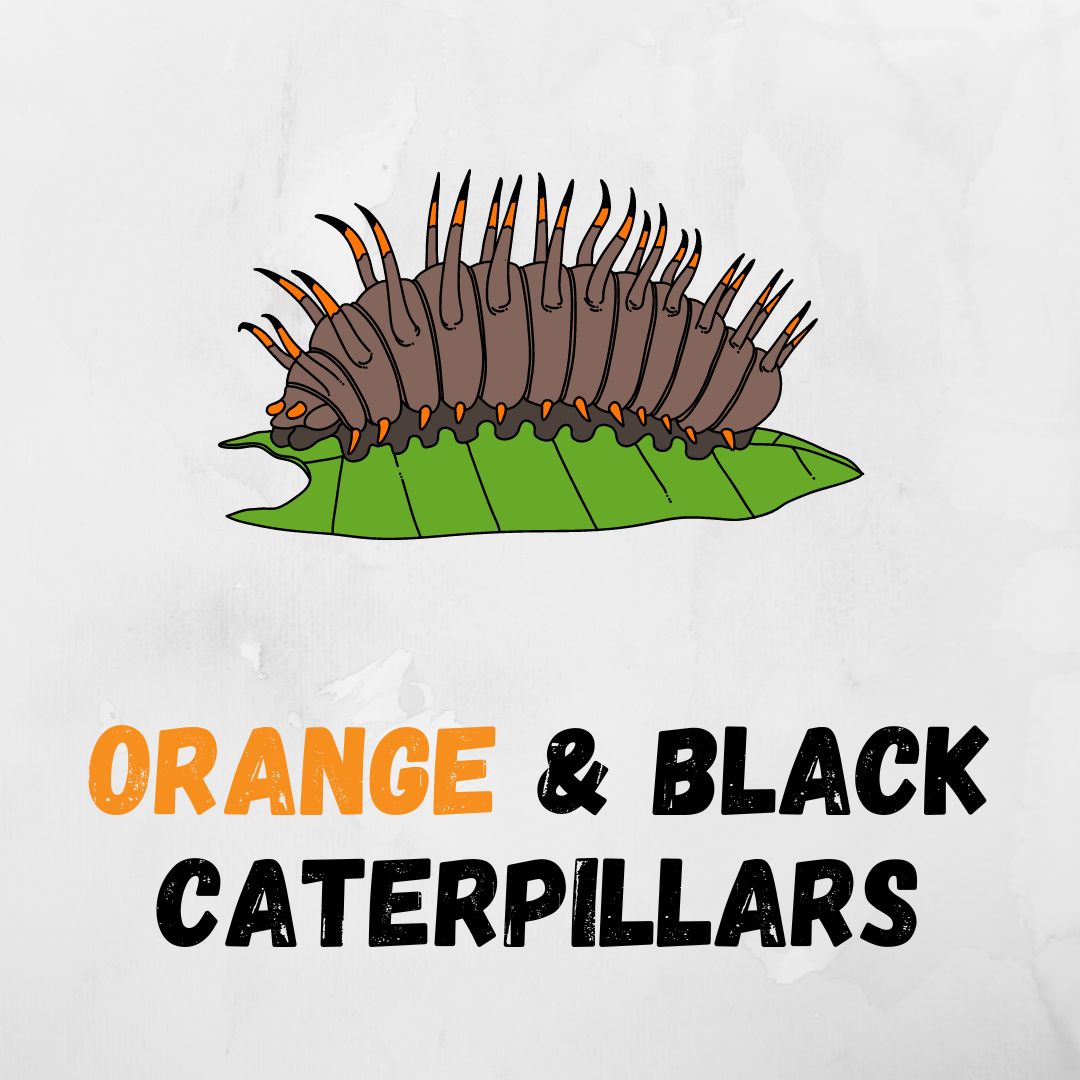Caterpillars are among the most intriguing and diverse creatures in the natural world. With their striking colors, unique patterns, and sometimes bizarre appearances, they captivate the imagination of nature enthusiasts and scientists alike. In this comprehensive exploration, we delve into the fascinating world of black and orange caterpillars, showcasing distinct species that exemplify the intricate beauty and diversity found within this color palette.
Post Contents
- Why Are Caterpillar Colors Important?
- 1. Pipevine Swallowtail Caterpillar (Battus philenor)
- 2. Red-humped Caterpillar (Schizura concinna)
- 3. Oleander Caterpillar (Syntomeida epilais)
- 4. Malachite Caterpillar (Siproeta stelenes)
- 5. Spiny Elm Caterpillar (Nymphalis antiopa)
- 6. Cinnabar Moth Caterpillar (Tyria jacobaeae)
- 7. Isabella Tiger Moth Caterpillar (Pyrrharctia isabella)
- 8. Gulf Fritillary Caterpillar (Agraulis vanillae)
- 9. Silvery Checkerspot Caterpillar (Chlosyne nycteis)
- 10. Variegated Fritillary Caterpillar (Euptoieta claudia)
- 11. Mexican Fritillary Caterpillar (Euptoieta hegesia)
- 12. Garden Tiger Caterpillar (Arctia caja)
- 13. Milkweed Tussock Moth Caterpillar (Euchaetes egle)
- 14. Long-winged Dagger Caterpillar (Acronicta auricoma)
- 15. Faithful Beauty Caterpillar (Composia fidelissima)
- 16. Pawpaw Webworm (Amphipyra pyramidoides)
- 17. Pine Conelet Looper Moth Caterpillar (Eulithis testata)
- 18. Clemens’ False Skeletonizer Caterpillar (Aplodes clemensii)
- 19. Pacific Tent Caterpillar (Malacosoma constrictum)
- 20. Apantesis incorrupta
- 21. Ranchman’s Tiger Moth Caterpillar (Platyprepia virginalis)
- 22. Wood Tiger Caterpillar (Parasemia plantaginis)
- 23. West Indian Mangrove Buckeye Caterpillar (Junonia evarete)
- 24. Spiny Oakworm (Anisota stigma)
- 25. Rusty Tussock Moth Caterpillar (Orgyia antiqua)
- 26. Cactus Moth Caterpillar (Cactoblastis cactorum)
- 27. Silver-spotted Tiger Moth Caterpillar (Lophocampa argentata)
- 28. Orange-tipped Oakworm (Anisota senatoria)
- 29. Unexpected Cycnia Moth Caterpillar (Cycnia inopinatus)
- 30. Buck Moth Caterpillar (Hemileuca maia)
- 31. Eastern Tent Caterpillar (Malacosoma americanum)
- 32. Yellow-winged Pareuchaetes Moth (Pareuchaetes insulata)
- 33. Legume Caterpillar (Uresiphita reversalis)
- 34. Baltimore Checkerspot Caterpillar (Euphydryas phaeton)
- 35. Sonoran Tent Caterpillar (Malacosoma sonorae)
- 36. Powdered Dagger Caterpillar (Acronicta leporina)
- 37. Large Gray Dagger Caterpillar (Acronicta megacephala)
- 38. Western Sheep Moth Caterpillar (Hemileuca eglanterina)
- Summary
Why Are Caterpillar Colors Important?
Before delving into the intriguing world of black and orange caterpillars, it’s essential to understand the significance of coloration in these remarkable creatures.
Caterpillars, the larval stage of butterflies and moths, come in a stunning array of colors and patterns. Their diverse appearances serve several vital purposes in their interactions with the environment and other organisms:
- Camouflage: Many caterpillars have evolved to blend seamlessly with their surroundings, helping them evade predators. Some black and orange caterpillars use this strategy to hide from birds, reptiles, and other potential threats.
- Warning Colors: In contrast, some caterpillars employ bold, contrasting colors like black and orange to advertise their toxicity or unpalatability. These colors serve as a warning to predators that consuming them may lead to illness or death.
- Mimicry: Caterpillars can mimic the appearance of other organisms, such as snakes or bird droppings, to deter predators.
- Species Identification: Caterpillar coloration often serves as a key identifier for entomologists and enthusiasts, aiding in species classification.
- Thermoregulation: Coloration can also influence a caterpillar’s ability to regulate its body temperature. Dark colors like black absorb heat, helping caterpillars warm up more quickly in the morning sun.
Now that we appreciate the role of coloration in the world of caterpillars, let’s embark on a journey to explore captivating types of black and orange caterpillars in greater detail.
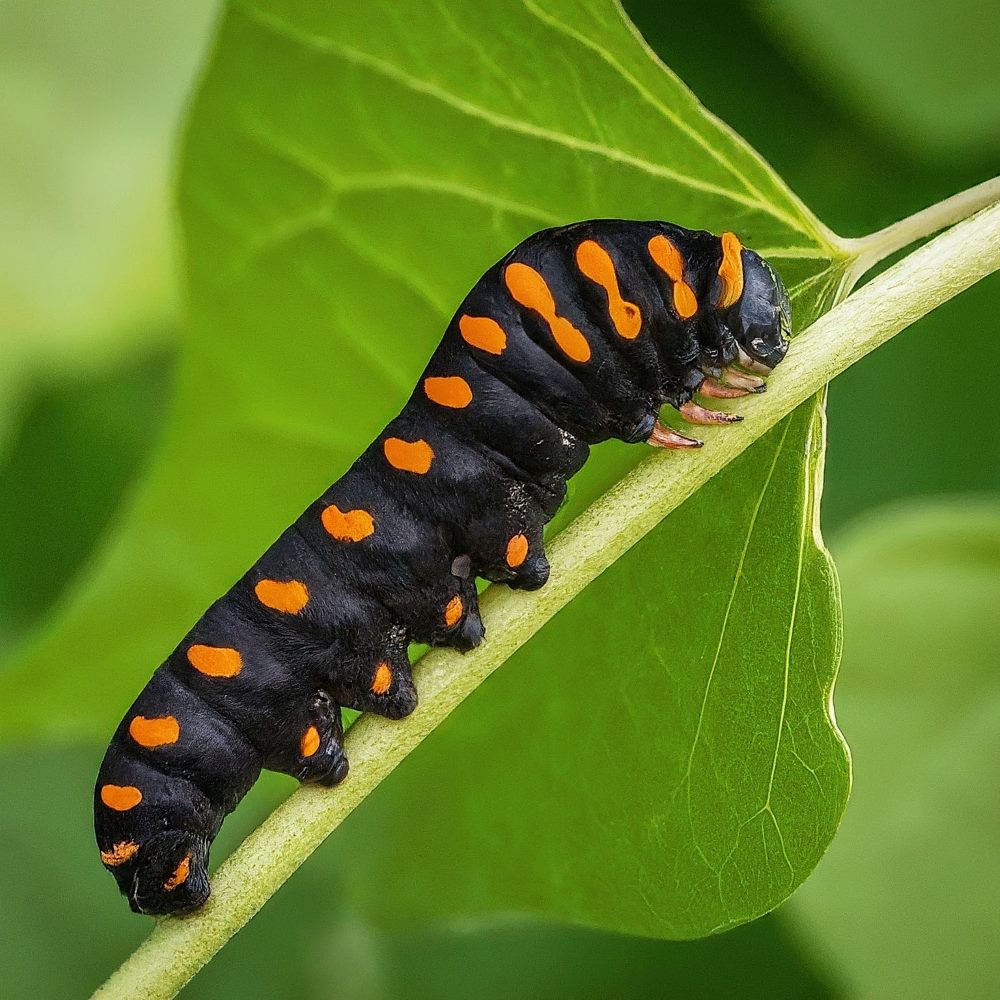
1. Pipevine Swallowtail Caterpillar (Battus philenor)
Appearance: Pipevine Swallowtail caterpillars feature striking black bodies adorned with bright orange spots and spines.
Habitat: These caterpillars are commonly found in North America, inhabiting woodlands, gardens, and meadows.
Diet: Pipevine Swallowtail caterpillars feed primarily on the leaves of pipevine plants (Aristolochia species).
Features and Facts: They possess osmeteria, which are forked, orange scent glands that they can protrude when threatened, emitting a foul odor to deter predators.
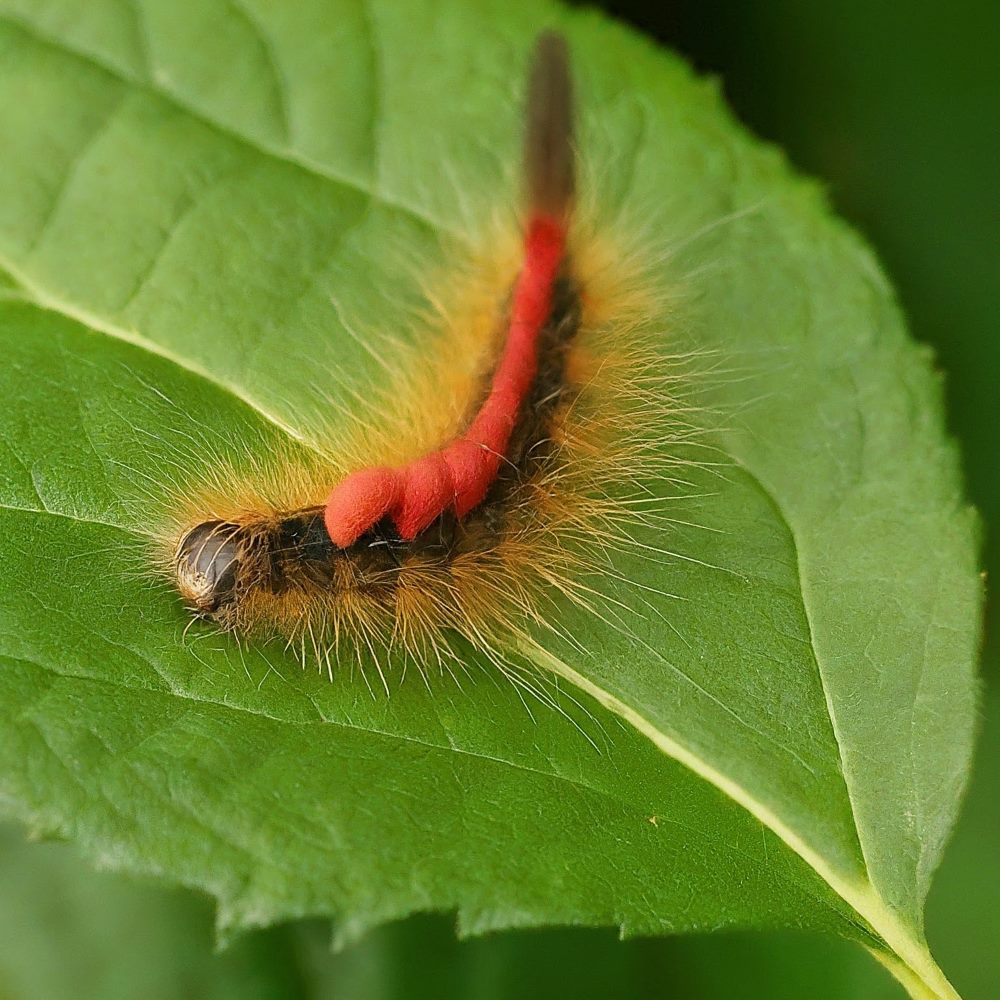
2. Red-humped Caterpillar (Schizura concinna)
Appearance: Red-humped caterpillars have black bodies with a distinctive red hump on their backs.
Habitat: These caterpillars are found throughout North America, particularly in deciduous forests and urban areas.
Diet: Red-humped caterpillars feed on the leaves of various trees, including oak, cherry, and apple trees.
Features and Facts: They are known for their synchronized group behavior, where they move in unison to create the appearance of a larger organism, deterring potential predators.
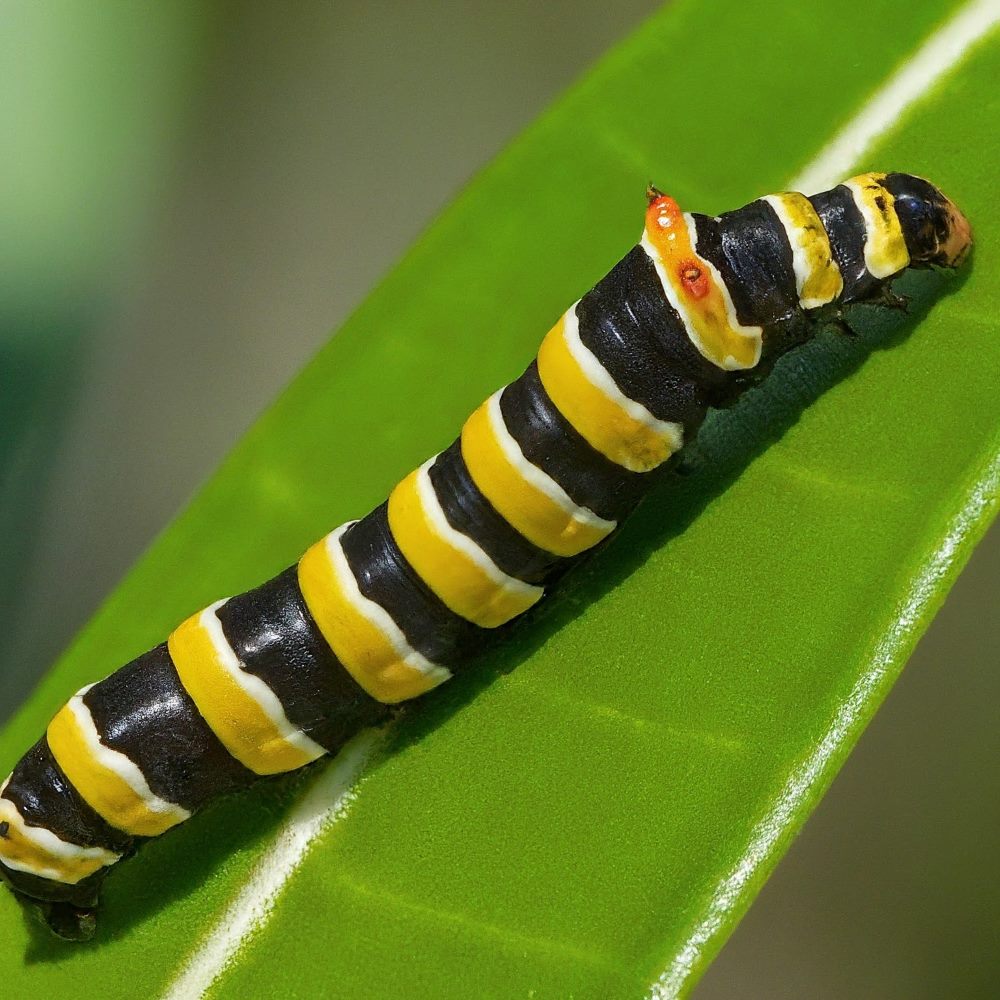
3. Oleander Caterpillar (Syntomeida epilais)
Appearance: Oleander caterpillars display vibrant orange bodies with black spots and longitudinal lines.
Habitat: Native to the southern United States, these caterpillars inhabit areas with oleander plants and other members of the Apocynaceae family.
Diet: Oleander caterpillars exclusively feed on the leaves of oleander plants (Nerium oleander).
Features and Facts: They possess stinging spines, making them unpalatable to many predators. Additionally, they undergo aposematic coloration, warning potential predators of their toxicity.
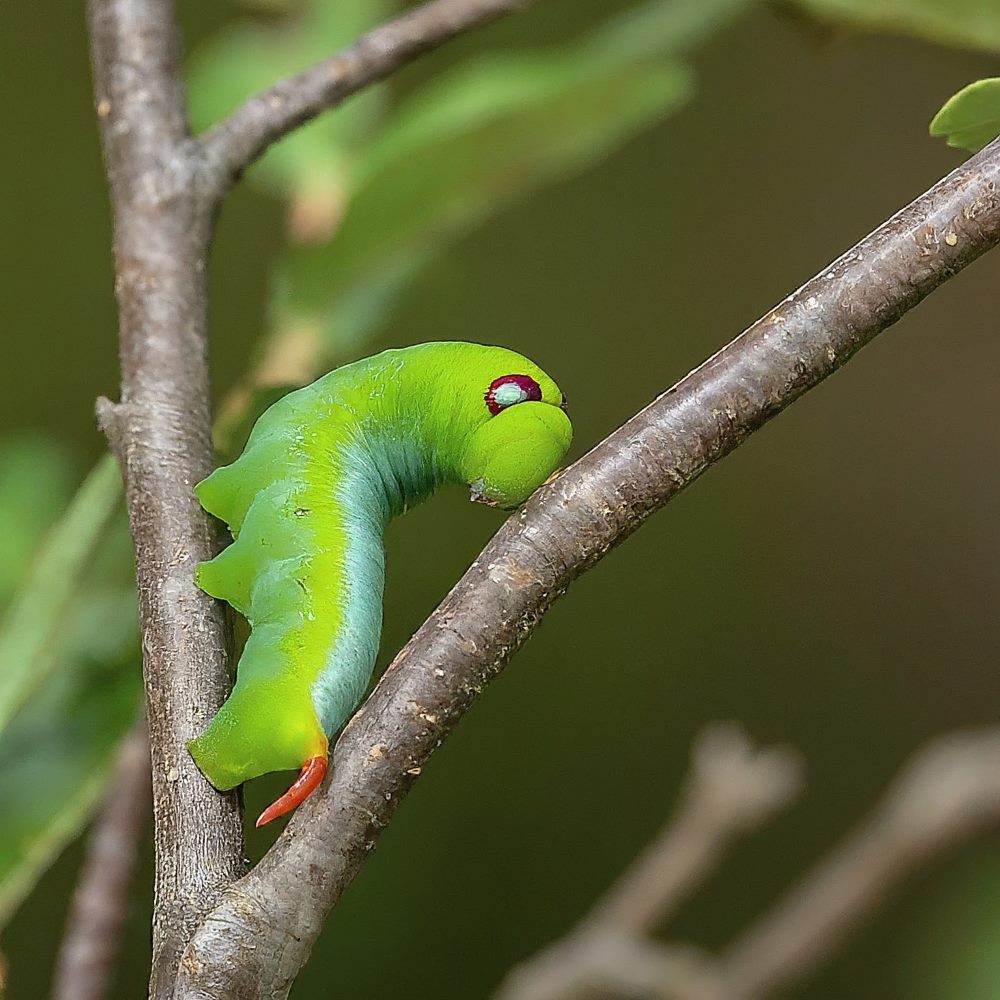
4. Malachite Caterpillar (Siproeta stelenes)
Appearance: Malachite caterpillars feature black bodies with striking orange bands and yellow spots.
Habitat: These caterpillars are primarily found in Central and South America, inhabiting tropical forests and gardens.
Diet: Malachite caterpillars feed on the leaves of various plants, including members of the Acanthaceae and Verbenaceae families.
Features and Facts: They possess retractable tentacles, which they extend when disturbed, releasing a pungent odor to deter predators. As adults, Malachite butterflies exhibit brilliant green wings with black and orange markings.
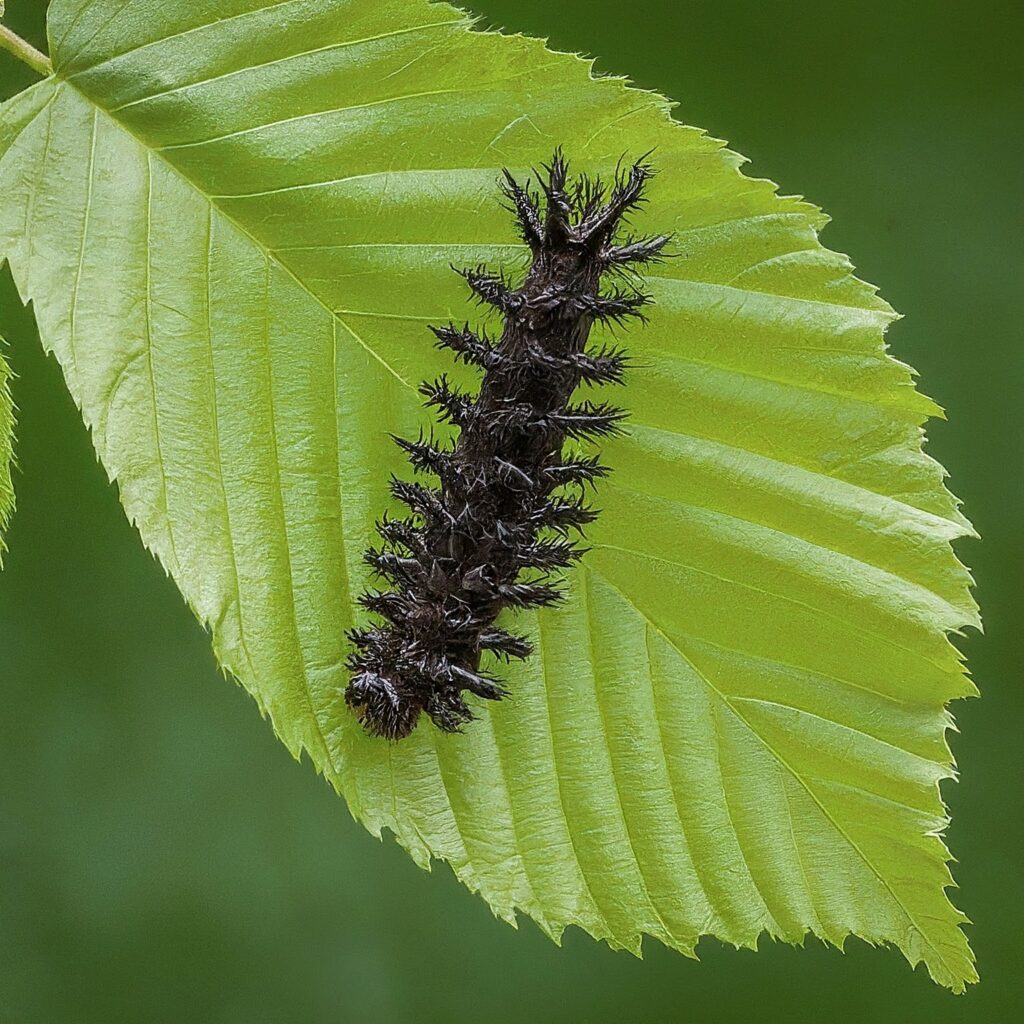
5. Spiny Elm Caterpillar (Nymphalis antiopa)
Appearance: Spiny Elm caterpillars have black bodies covered in long, branched spines and orange bands along their sides.
Habitat: These caterpillars are widespread across North America, particularly in deciduous forests and urban areas.
Diet: Spiny Elm caterpillars primarily feed on the leaves of elm trees (Ulmus species), particularly American elm.
Features and Facts: They undergo a fascinating color change before pupation, transitioning from black with orange bands to pale green. Additionally, they possess urticating hairs, which can cause skin irritation upon contact.
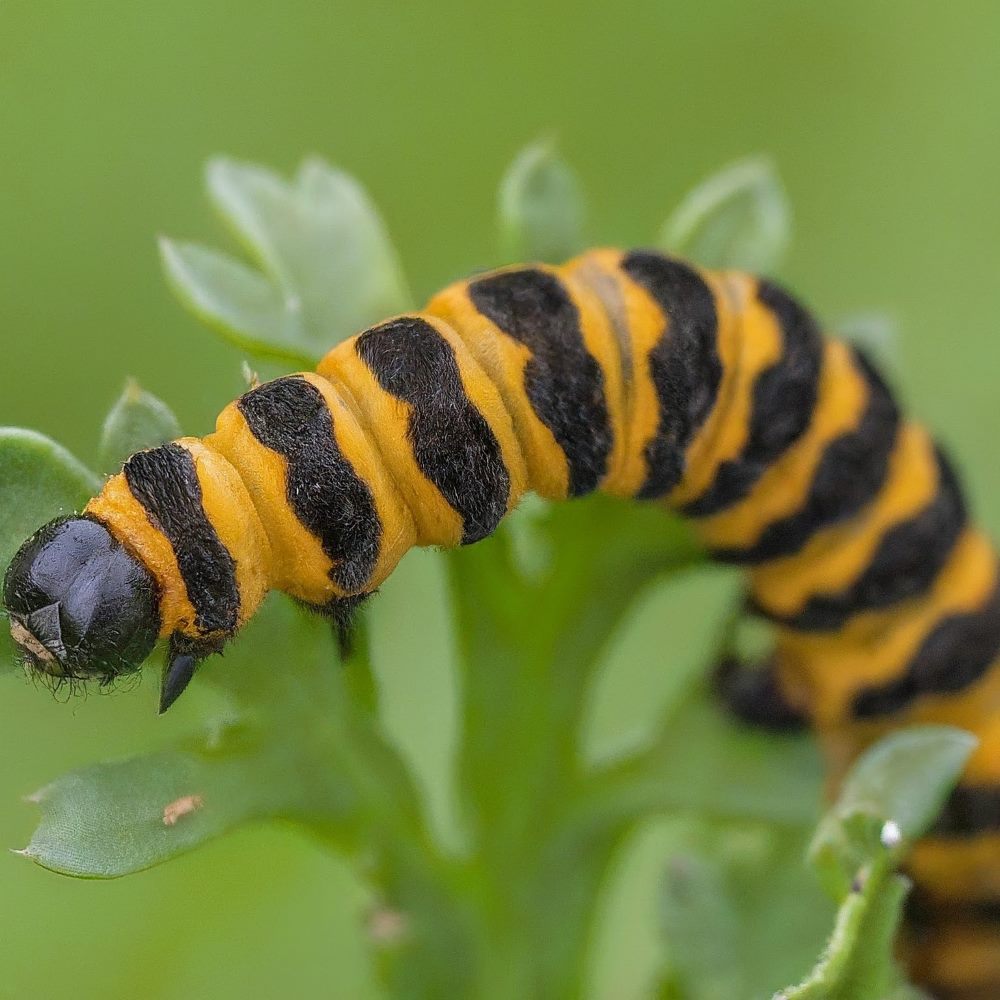
6. Cinnabar Moth Caterpillar (Tyria jacobaeae)
Appearance: Cinnabar Moth caterpillars showcase vibrant black and orange stripes along their bodies.
Habitat: Native to Europe and Asia, these caterpillars are commonly found in grasslands, meadows, and disturbed areas.
Diet: Cinnabar Moth caterpillars exclusively feed on the leaves of ragwort plants (Senecio species), which contain toxic alkaloids.
Features and Facts: They are known for their aposematic coloration, warning predators of their toxicity due to their consumption of toxic host plants. Additionally, they have been introduced to various regions as a biological control agent for ragwort infestations.
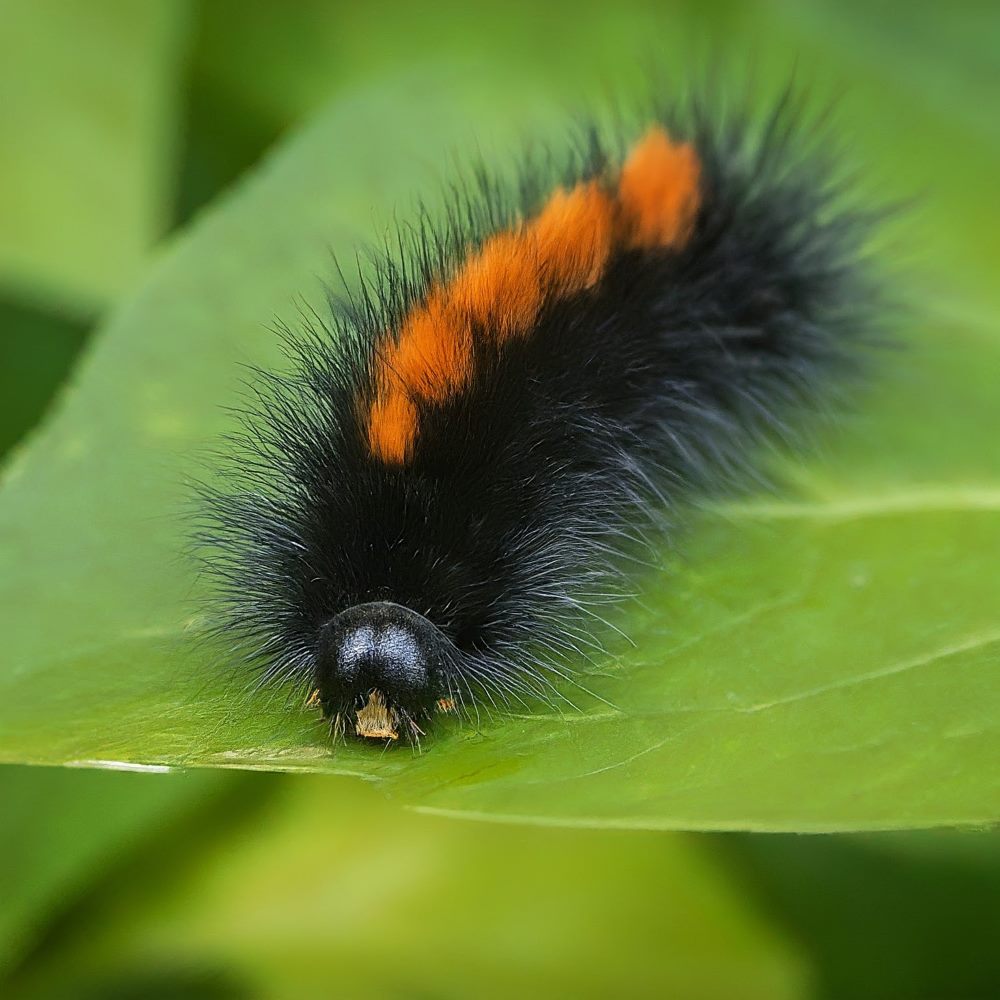
7. Isabella Tiger Moth Caterpillar (Pyrrharctia isabella)
Appearance: Isabella Tiger Moth caterpillars have fuzzy, orange-brown bodies with black tufts of hair and rows of black spots along their sides.
Habitat: These caterpillars are widespread across North America, inhabiting grasslands, fields, and agricultural areas.
Diet: Isabella Tiger Moth caterpillars feed on a variety of plants, including dandelions, clover, and grasses.
Features and Facts: They are known for their woolly appearance and can roll into a tight ball when disturbed, displaying their bright orange underparts as a warning signal to predators.
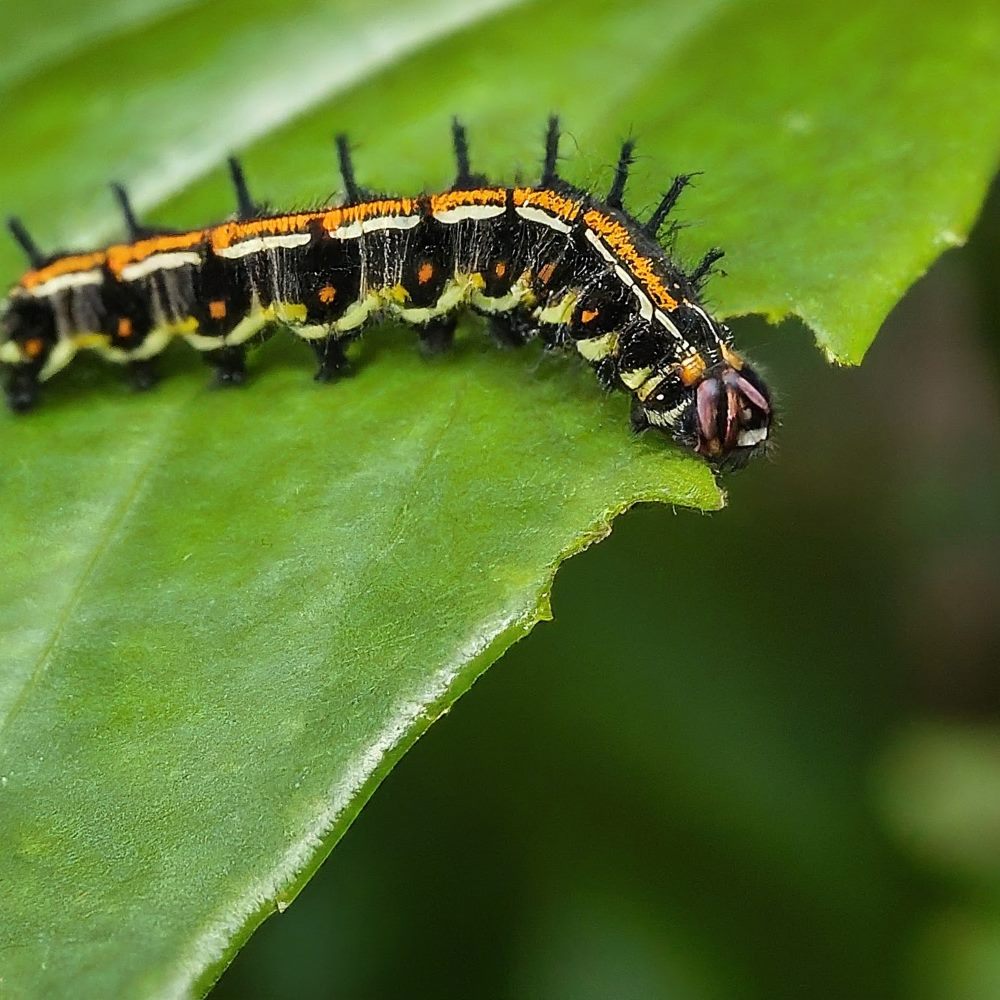
8. Gulf Fritillary Caterpillar (Agraulis vanillae)
Appearance: Gulf Fritillary caterpillars feature black bodies adorned with rows of bright orange spines and spots.
Habitat: These caterpillars are native to the southern United States and are commonly found in open habitats, including fields, gardens, and roadsides.
Diet: Gulf Fritillary caterpillars feed on the leaves of various passionflower vine species (Passiflora species).
Features and Facts: They are toxic to predators due to their consumption of toxic passionflower plants, which they sequester toxins from to defend against predation. Gulf Fritillary butterflies display vibrant orange wings with black markings as adults.
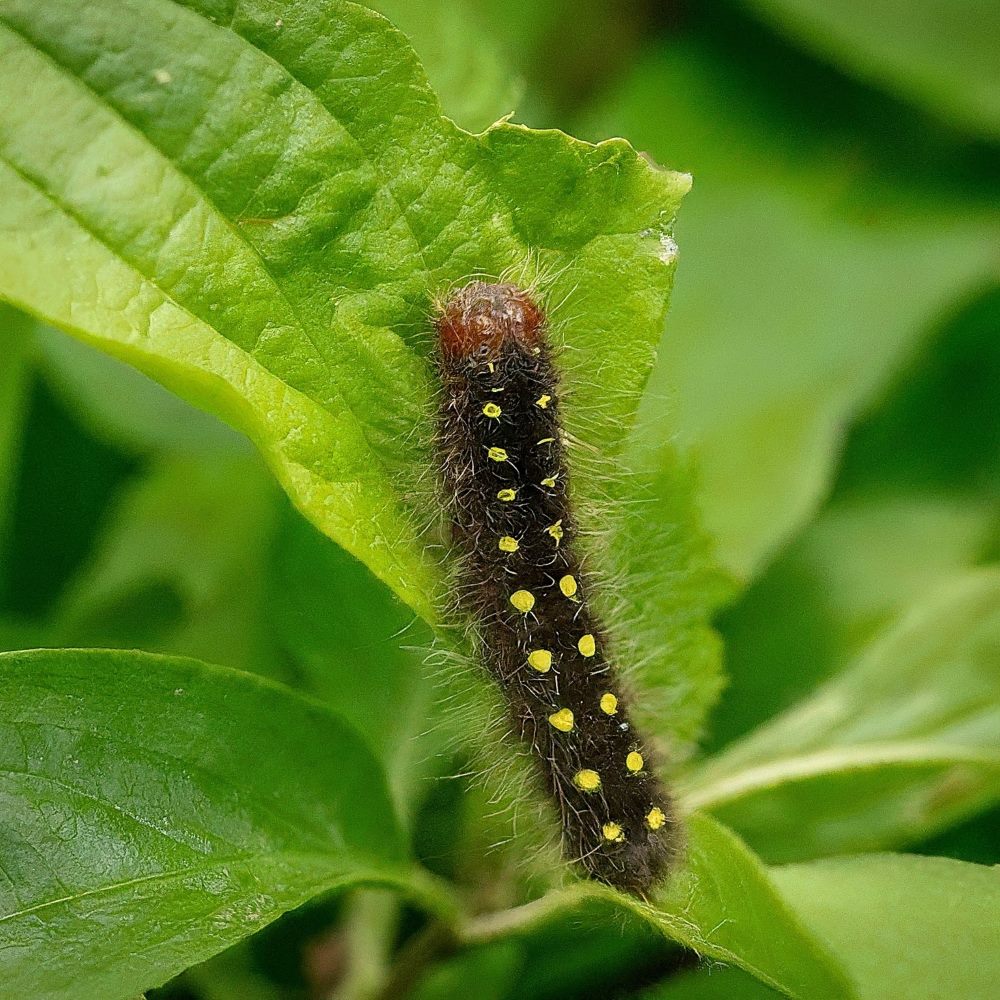
9. Silvery Checkerspot Caterpillar (Chlosyne nycteis)
Appearance: Silvery Checkerspot caterpillars have black bodies with rows of bright orange spikes and silver-white markings along their sides.
Habitat: These caterpillars are found across North America, particularly in grasslands, meadows, and open woodlands.
Diet: Silvery Checkerspot caterpillars feed on the leaves of various plants, including sunflowers, asters, and legumes.
Features and Facts: They undergo diapause, a period of suspended development, during the winter months, hibernating until favorable environmental conditions return in the spring. As adults, Silvery Checkerspot butterflies display striking orange and black wings with silver-white markings.
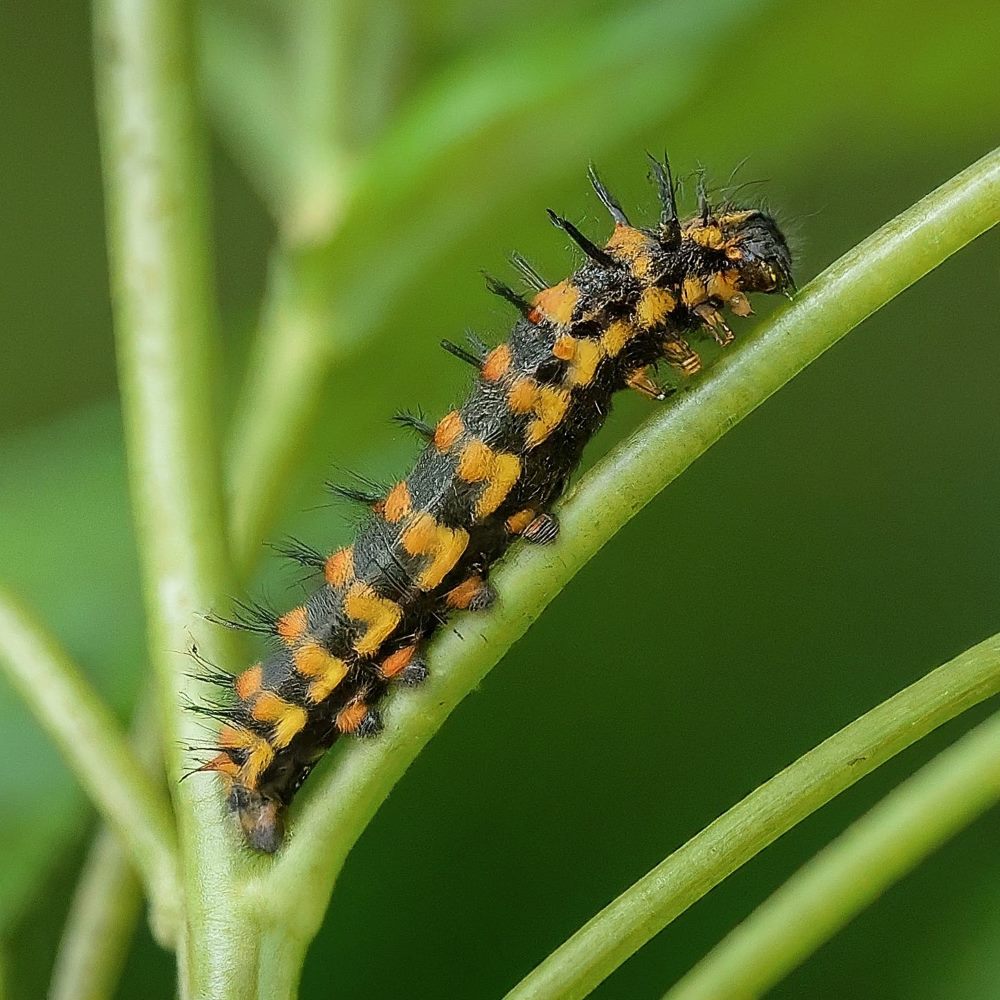
10. Variegated Fritillary Caterpillar (Euptoieta claudia)
Appearance: Variegated Fritillary caterpillars feature black bodies adorned with rows of spines and bands of orange, white, and black along their sides.
Habitat: These caterpillars are widespread across North and South America, inhabiting open habitats such as fields, meadows, and roadsides.
Diet: Variegated Fritillary caterpillars feed on the leaves of various plants, including violets, passionflowers, and nettles.
Features and Facts: They display variable coloration and patterns, making them cryptic against their diverse range of host plants. Variegated Fritillary butterflies exhibit wings with intricate patterns of orange, black, and silver as adults.
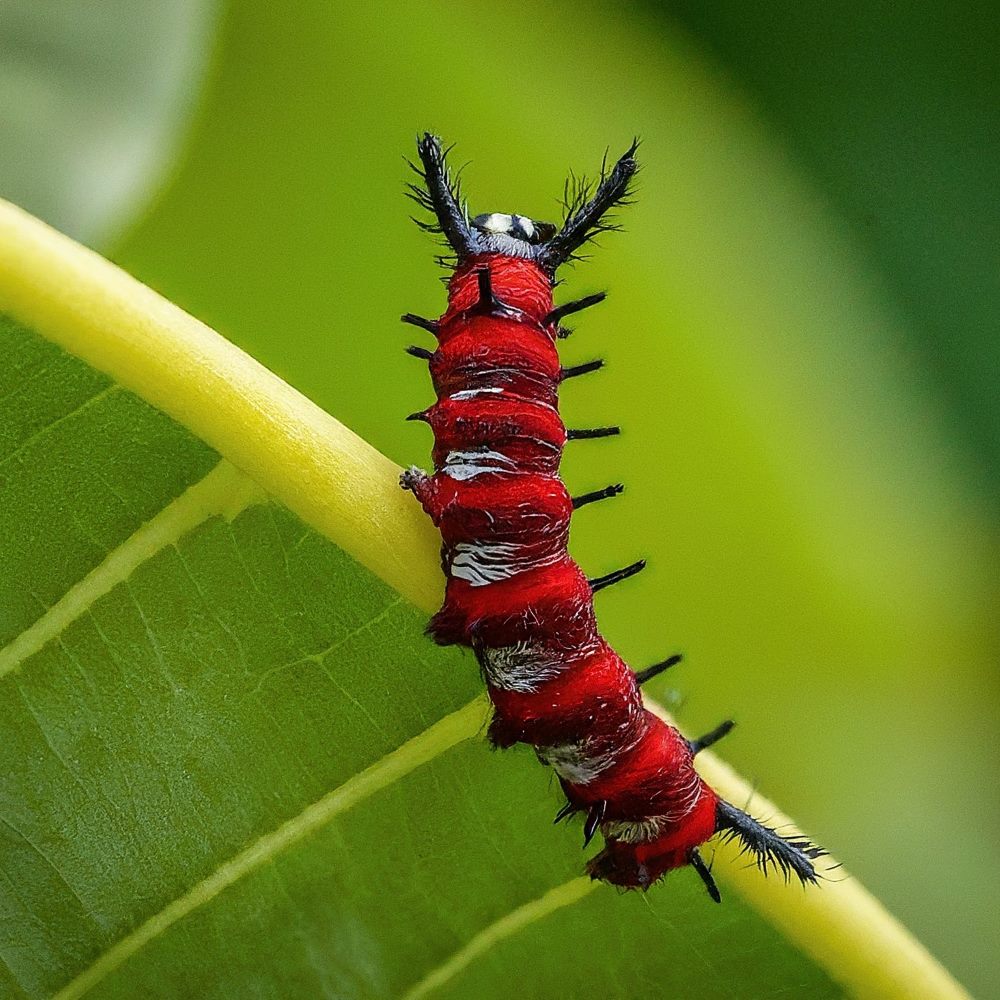
11. Mexican Fritillary Caterpillar (Euptoieta hegesia)
Appearance: Mexican Fritillary caterpillars have black bodies with rows of bright orange spikes and white markings along their sides.
Habitat: These caterpillars are native to Central and South America, particularly in open habitats such as grasslands and meadows.
Diet: Mexican Fritillary caterpillars feed on the leaves of various plants, including passionflowers and nettles.
Features and Facts: They are highly mobile and may migrate in large numbers to find suitable breeding and feeding grounds. Mexican Fritillary butterflies display vibrant orange wings with black markings as adults.
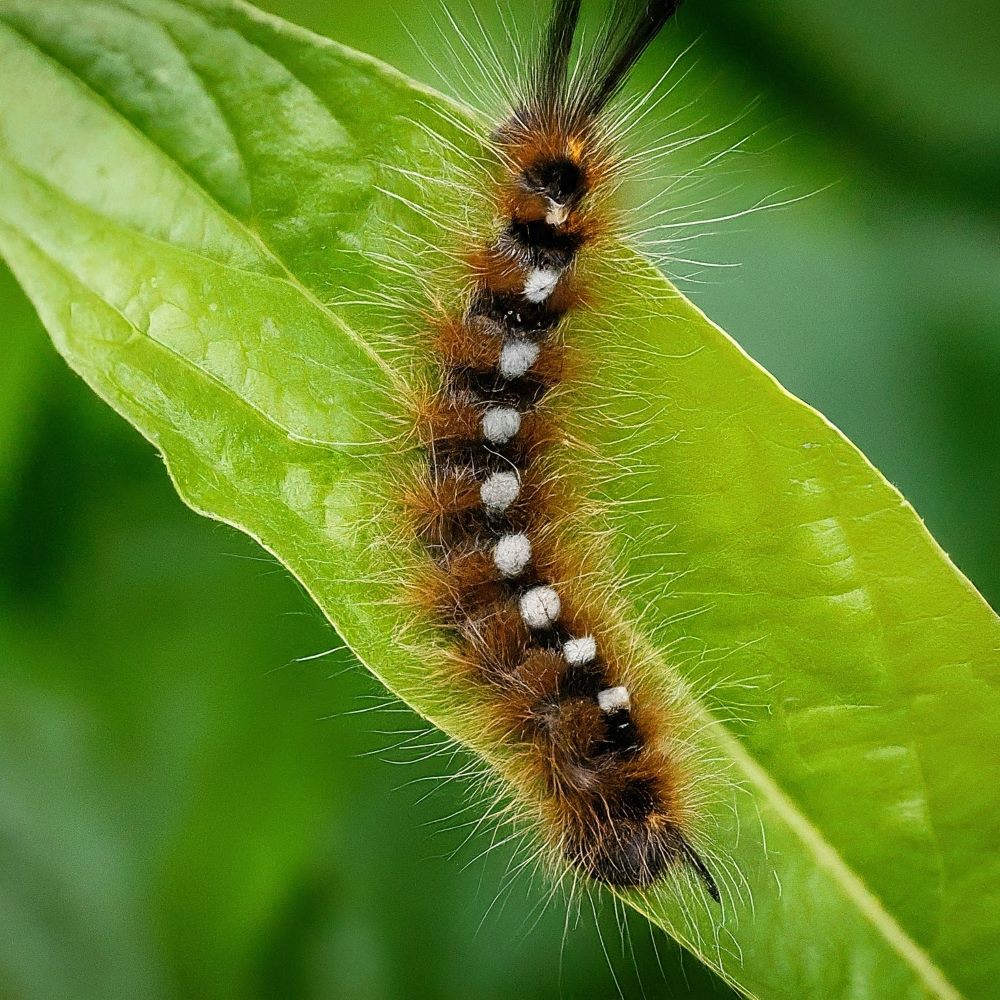
12. Garden Tiger Caterpillar (Arctia caja)
Appearance: Garden Tiger caterpillars feature hairy black bodies with alternating orange and black bands along their sides.
Habitat: These caterpillars are found across Europe and Asia, particularly in gardens, meadows, and urban areas.
Diet: Garden Tiger caterpillars feed on a wide range of plants, including nettles, dandelions, and sunflowers.
Features and Facts: They possess urticating hairs, which can cause skin irritation upon contact, serving as a defense mechanism against predators. Garden Tiger moths exhibit striking orange and black wings with white spots as adults.
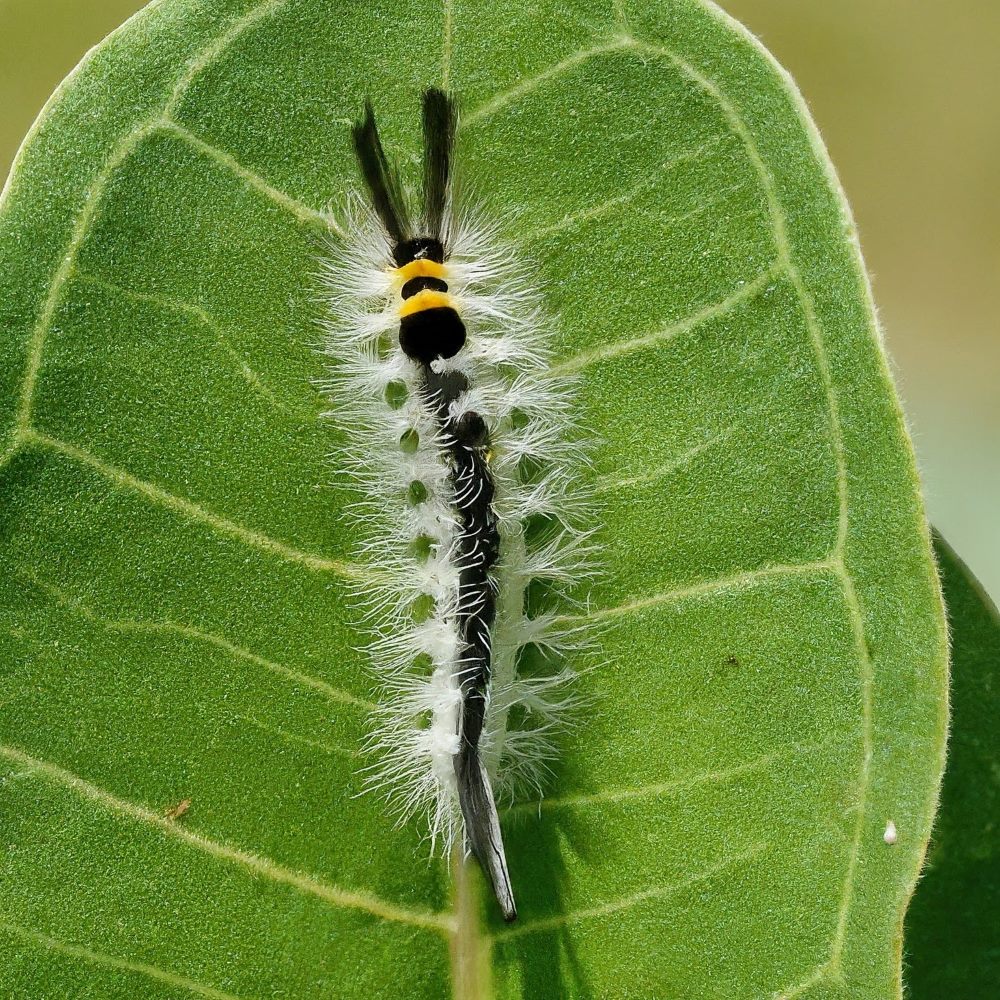
13. Milkweed Tussock Moth Caterpillar (Euchaetes egle)
Appearance: Milkweed Tussock Moth caterpillars have black bodies with tufts of orange, black, and white hairs along their backs.
Habitat: These caterpillars are commonly found in North America, particularly in fields, meadows, and gardens with milkweed plants.
Diet: Milkweed Tussock Moth caterpillars feed exclusively on the leaves of milkweed plants (Asclepias species).
Features and Facts: They sequester toxic compounds from milkweed plants, making them unpalatable to many predators. Additionally, their bright coloration serves as a warning signal to potential predators.
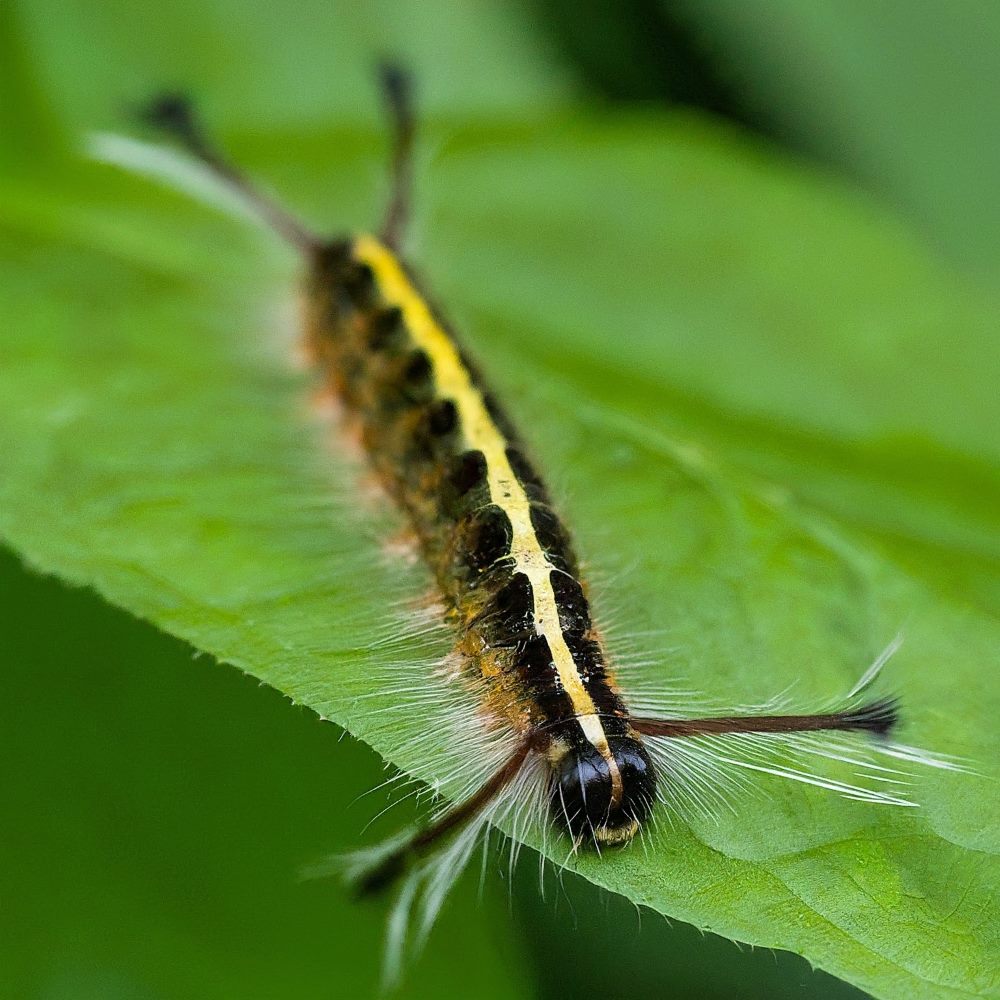
14. Long-winged Dagger Caterpillar (Acronicta auricoma)
Appearance: Long-winged Dagger caterpillars feature black bodies with rows of bright orange spikes and white markings along their sides.
Habitat: These caterpillars are found across Europe and Asia, particularly in woodlands, forests, and urban areas.
Diet: Long-winged Dagger caterpillars feed on the leaves of various trees, including oak, birch, and willow.
Features and Facts: They are nocturnal feeders, hiding during the day and emerging at night to feed on foliage. As adults, Long-winged Dagger moths display intricate patterns of orange, black, and white on their wings.
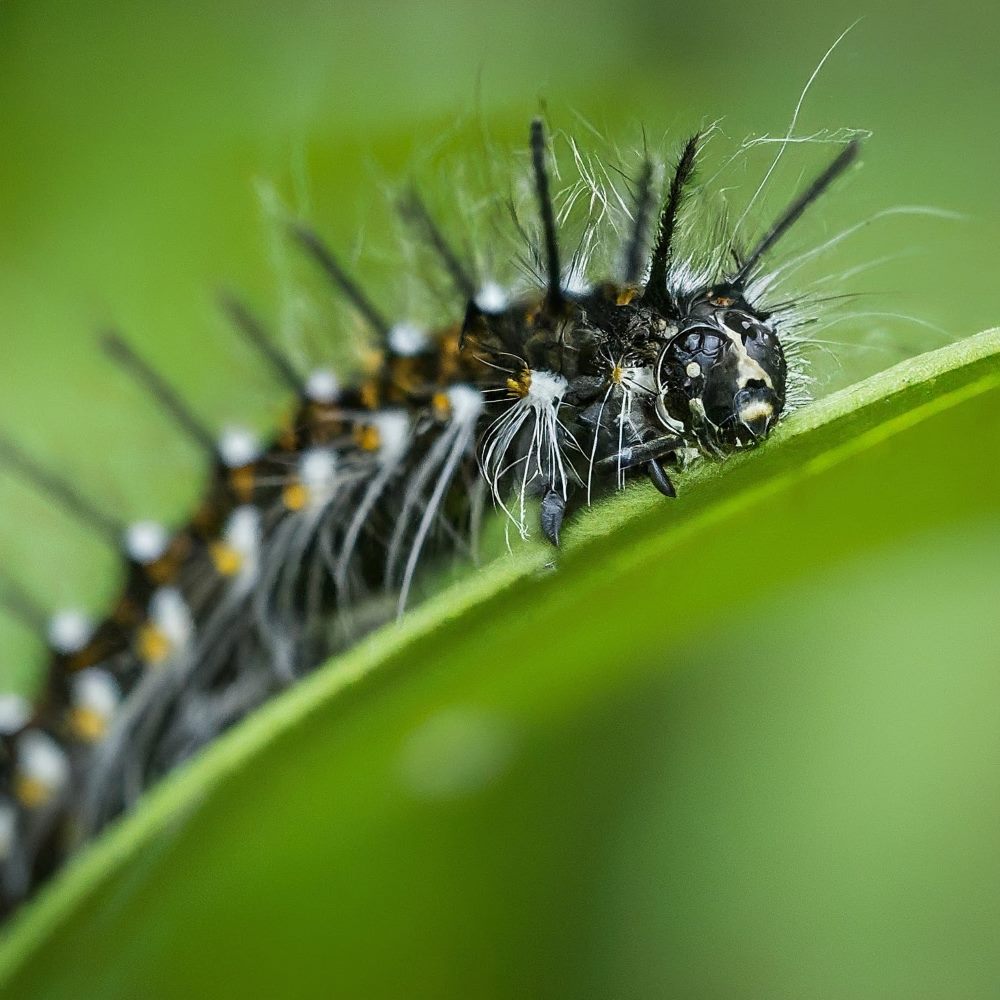
15. Faithful Beauty Caterpillar (Composia fidelissima)
Appearance: Faithful Beauty caterpillars have black bodies with bright orange bands and rows of spines along their backs.
Habitat: These caterpillars are native to North America and are commonly found in open habitats such as fields, meadows, and gardens.
Diet: Faithful Beauty caterpillars feed on the leaves of various plants, including legumes, asters, and sunflowers.
Features and Facts: They undergo aposematic coloration, warning potential predators of their toxicity due to their consumption of toxic host plants. Faithful Beauty moths exhibit vibrant orange and black wings with white markings as adults.
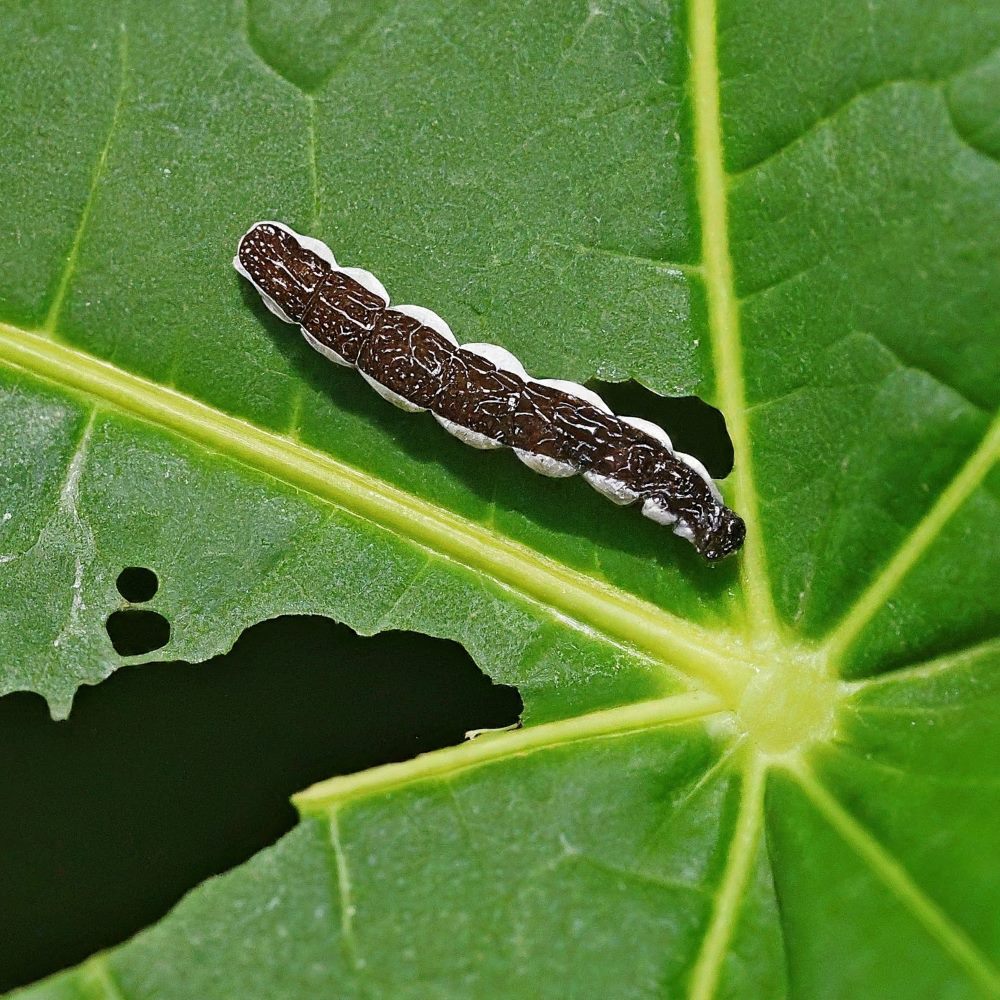
16. Pawpaw Webworm (Amphipyra pyramidoides)
Appearance: Pawpaw Webworm caterpillars feature black bodies with rows of bright orange spots and white stripes along their sides.
Habitat: These caterpillars are primarily found in North America, particularly in deciduous forests and woodlands.
Diet: Pawpaw Webworm caterpillars feed on the leaves of pawpaw trees (Asimina species) and other members of the Annonaceae family.
Features and Facts: They construct silk webs around leaves for protection and feeding, creating distinctive shelters. Pawpaw Webworm moths exhibit wings with intricate patterns of orange, black, and white as adults.
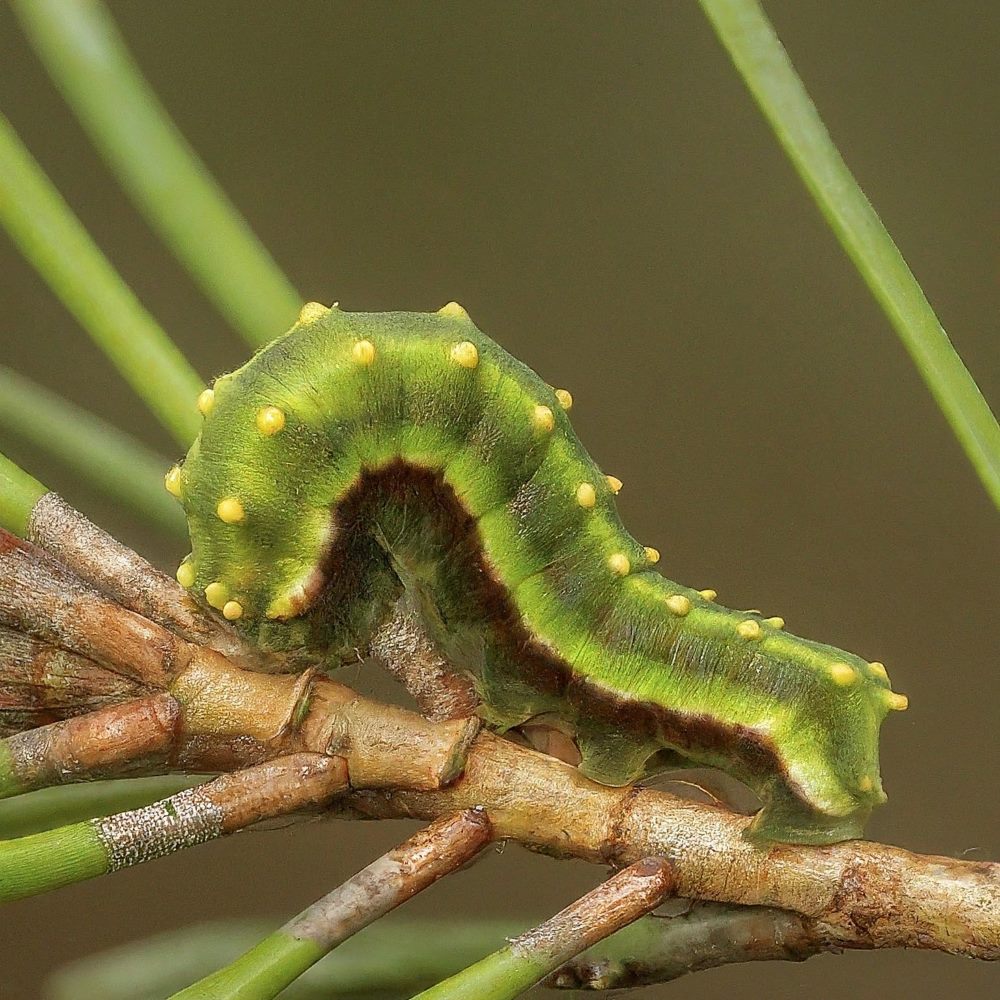
17. Pine Conelet Looper Moth Caterpillar (Eulithis testata)
Appearance: Pine Conelet Looper caterpillars have black bodies with rows of bright orange spikes and longitudinal stripes along their sides.
Habitat: These caterpillars are found across North America, particularly in coniferous forests and woodlands.
Diet: Pine Conelet Looper caterpillars feed on the leaves of various coniferous trees, including pine, spruce, and fir.
Features and Facts: They are cryptic against their host plants, blending in with pine needles and cones. As adults, Pine Conelet Looper moths exhibit wings with intricate patterns of orange, black, and white.
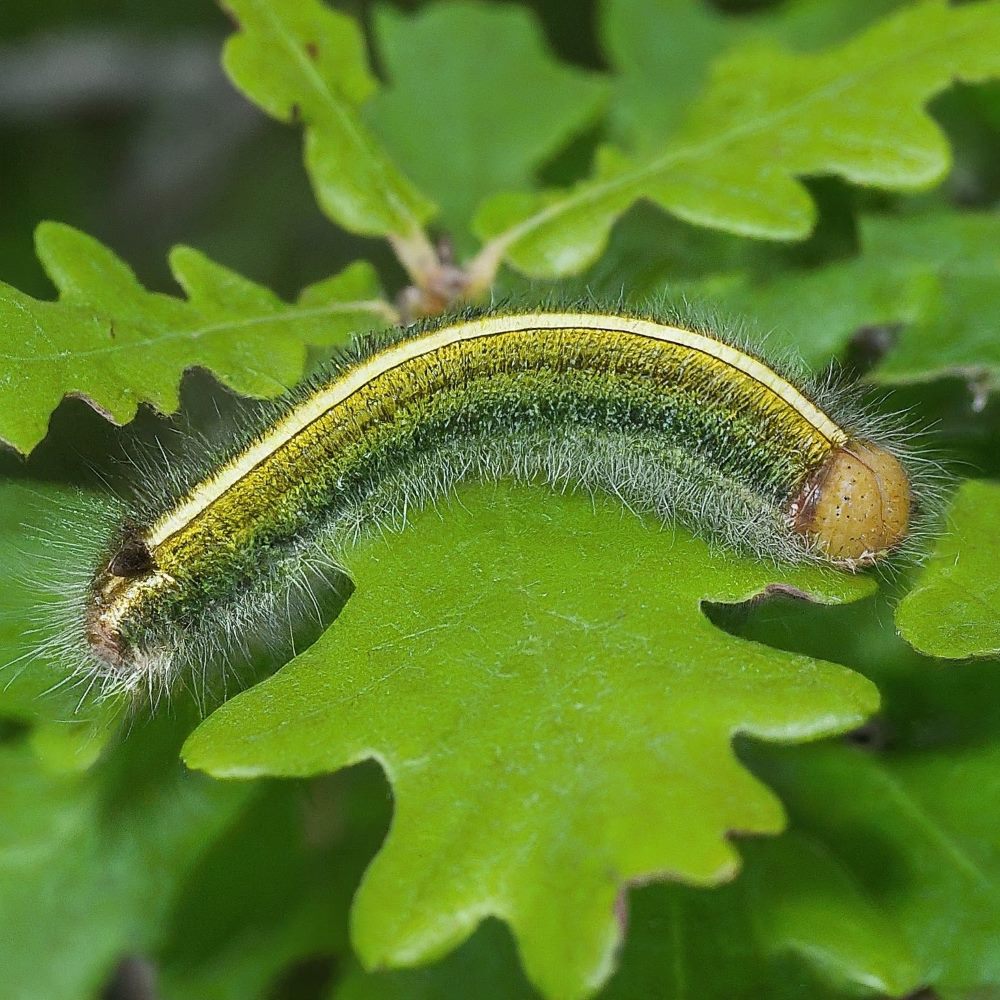
18. Clemens’ False Skeletonizer Caterpillar (Aplodes clemensii)
Appearance: Clemens’ False Skeletonizer caterpillars feature black bodies with rows of bright orange spots and longitudinal stripes along their sides.
Habitat: These caterpillars are primarily found in North America, inhabiting deciduous forests and woodlands.
Diet: Clemens’ False Skeletonizer caterpillars feed on the leaves of various trees, including oak, hickory, and walnut.
Features and Facts: They are known for their synchronized group behavior, where they move in unison to create the appearance of a larger organism, deterring potential predators. Clemens’ False Skeletonizer moths exhibit wings with intricate patterns of orange, black, and white as adults.
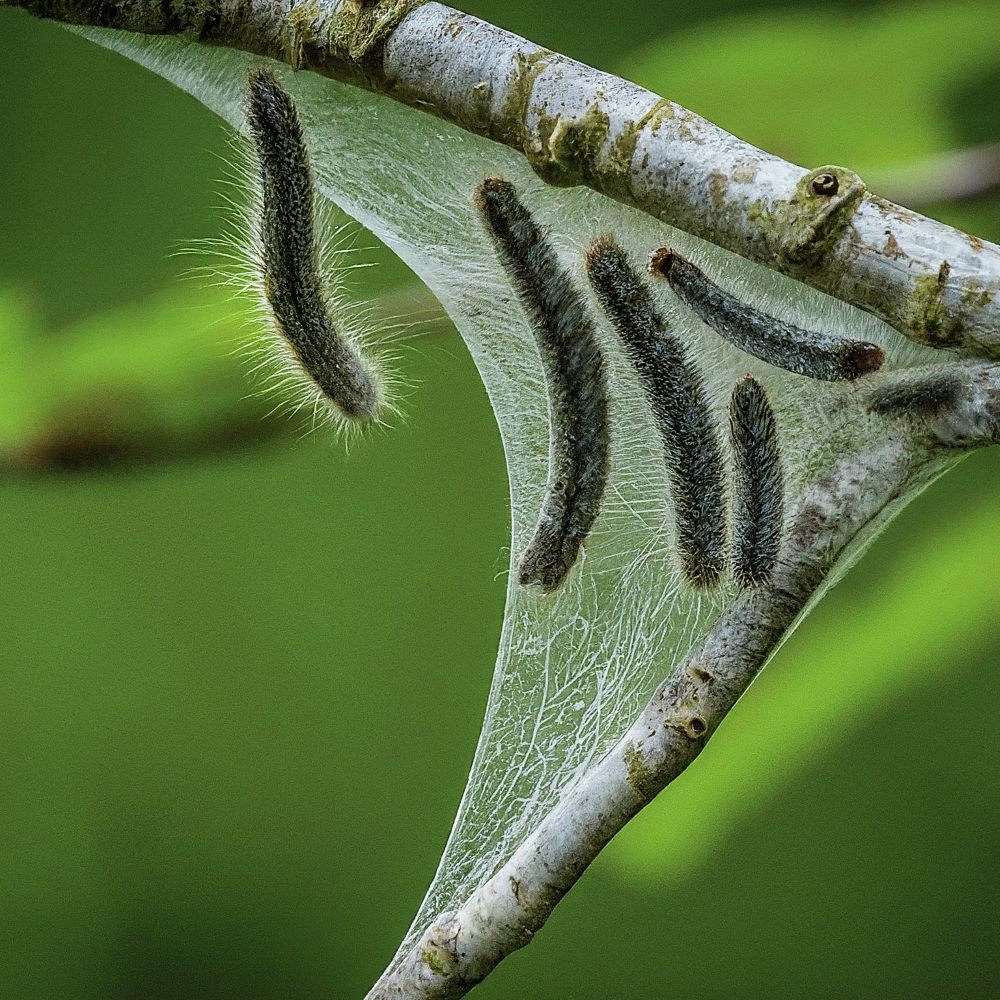
19. Pacific Tent Caterpillar (Malacosoma constrictum)
Appearance: Pacific Tent caterpillars have black bodies with rows of bright orange spots and longitudinal stripes along their sides.
Habitat: These caterpillars are found along the Pacific coast of North America, particularly in forests, woodlands, and urban areas.
Diet: Pacific Tent caterpillars feed on the leaves of various trees, including alder, willow, and maple.
Features and Facts: They construct silk tents in the branches of trees, where they rest and feed communally. As adults, Pacific Tent moths exhibit wings with intricate patterns of orange, black, and white.
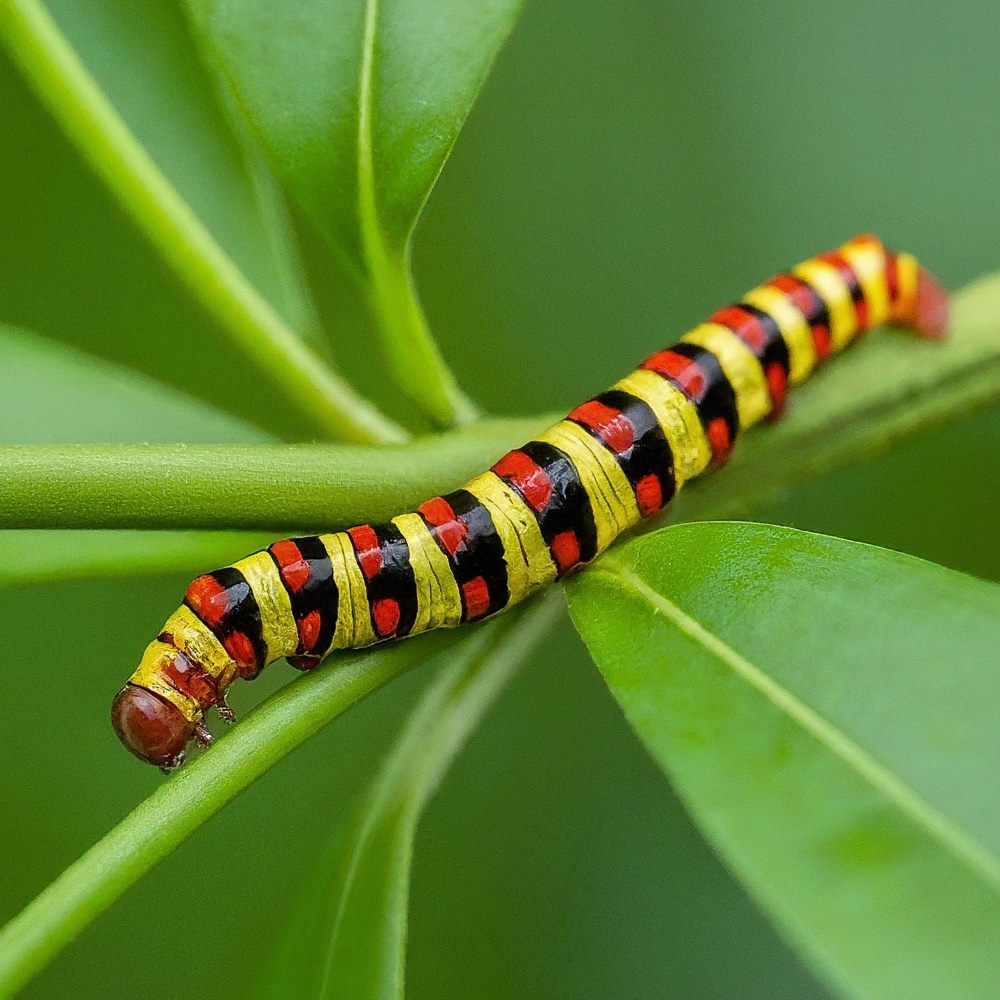
20. Apantesis incorrupta
Appearance: Apantesis incorrupta caterpillars have black bodies with rows of bright orange spots and longitudinal stripes along their sides.
Habitat: These caterpillars are primarily found in North America, inhabiting grasslands, meadows, and urban areas.
Diet: Apantesis incorrupta caterpillars feed on the leaves of various plants, including grasses, dandelions, and legumes.
Features and Facts: They are cryptic against their host plants, blending in with grasses and foliage. Apantesis incorrupta moths exhibit wings with intricate patterns of orange, black, and white as adults.
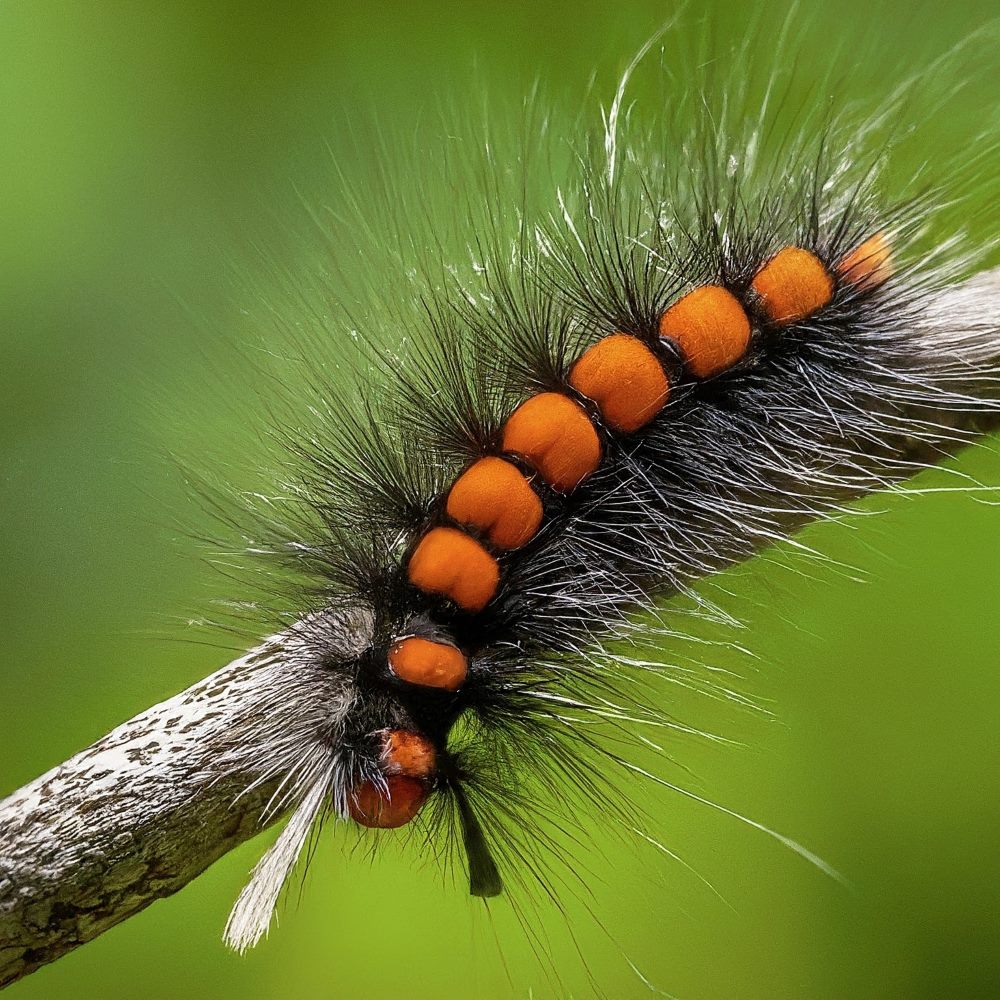
21. Ranchman’s Tiger Moth Caterpillar (Platyprepia virginalis)
Appearance: Ranchman’s Tiger Moth caterpillars feature black bodies with bright orange bands and rows of spines along their backs.
Habitat: These caterpillars are native to North America and are commonly found in grasslands, meadows, and agricultural areas.
Diet: Ranchman’s Tiger Moth caterpillars feed on the leaves of various plants, including grasses, dandelions, and legumes.
Features and Facts: They possess urticating hairs, which can cause skin irritation upon contact, serving as a defense mechanism against predators. Ranchman’s Tiger Moth moths exhibit wings with intricate patterns of orange, black, and white as adults.
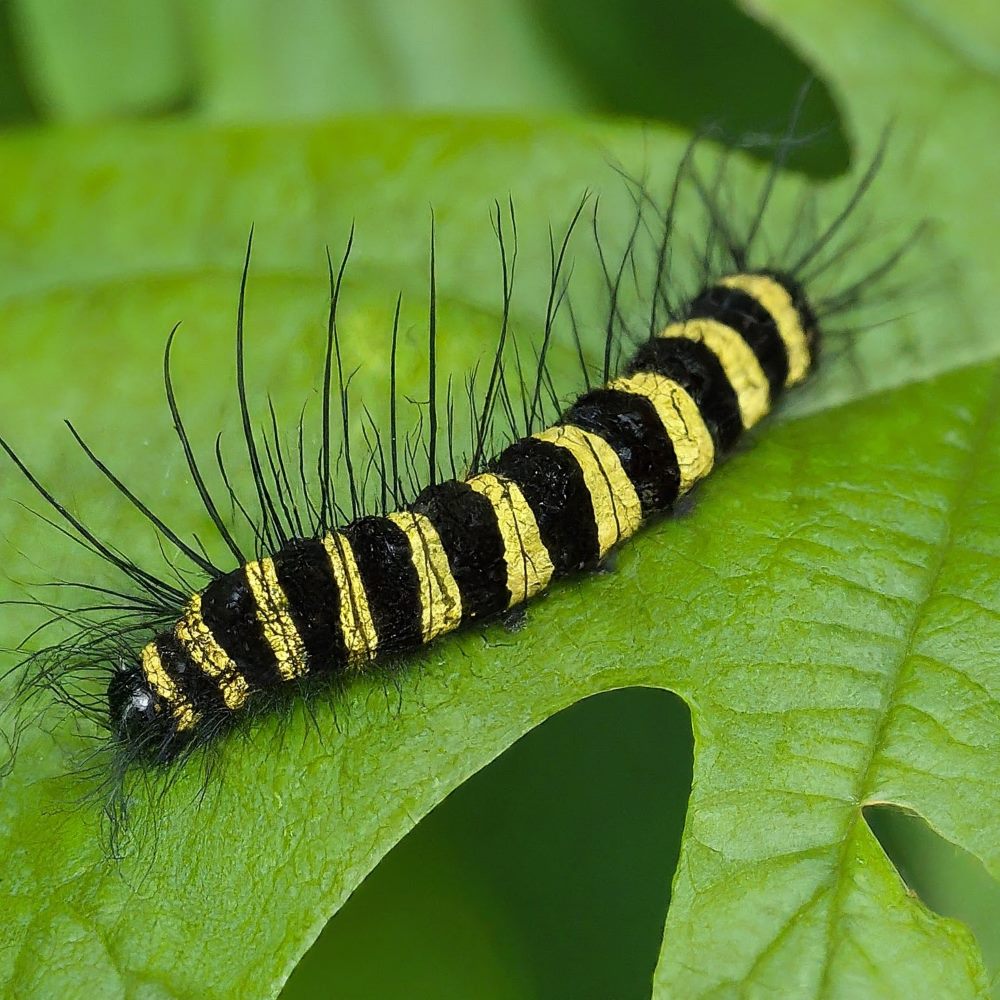
22. Wood Tiger Caterpillar (Parasemia plantaginis)
Appearance: Wood Tiger caterpillars have black bodies with bright orange bands and rows of spines along their backs.
Habitat: These caterpillars are found across Europe and Asia, particularly in woodlands, forests, and meadows.
Diet: Wood Tiger caterpillars feed on the leaves of various plants, including violets, dandelions, and grasses.
Features and Facts: They are known for their synchronized group behavior, where they move in unison to create the appearance of a larger organism, deterring potential predators. Wood Tiger moths exhibit wings with intricate patterns of orange, black, and white as adults.
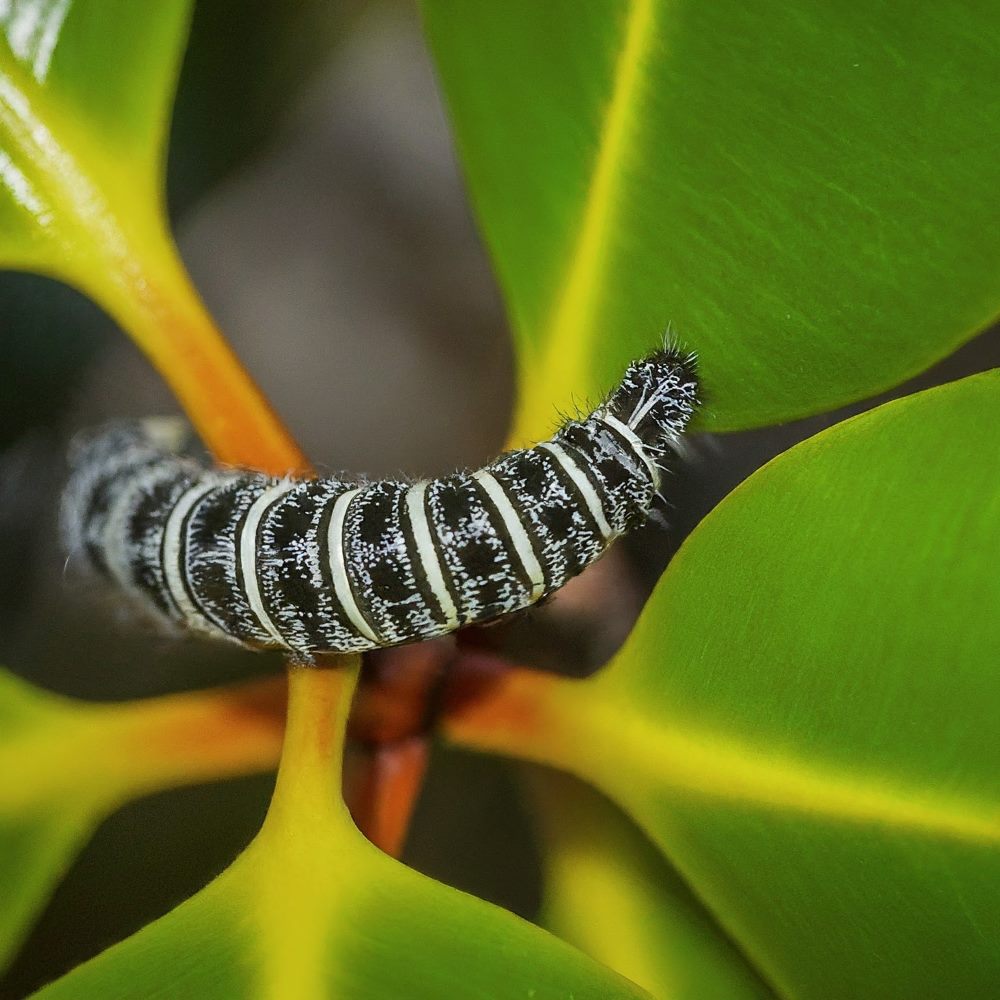
23. West Indian Mangrove Buckeye Caterpillar (Junonia evarete)
Appearance: West Indian Mangrove Buckeye caterpillars feature black bodies with rows of bright orange spots and stripes along their sides.
Habitat: These caterpillars are primarily found in coastal areas of the Americas, particularly in mangrove forests and wetlands.
Diet: West Indian Mangrove Buckeye caterpillars feed on the leaves of various mangrove species, including red mangrove (Rhizophora mangle) and black mangrove (Avicennia germinans).
Features and Facts: They are adapted to saline environments, where they feed on salt-tolerant mangrove plants. As adults, West Indian Mangrove Buckeye butterflies exhibit wings with intricate patterns of orange, black, and white.
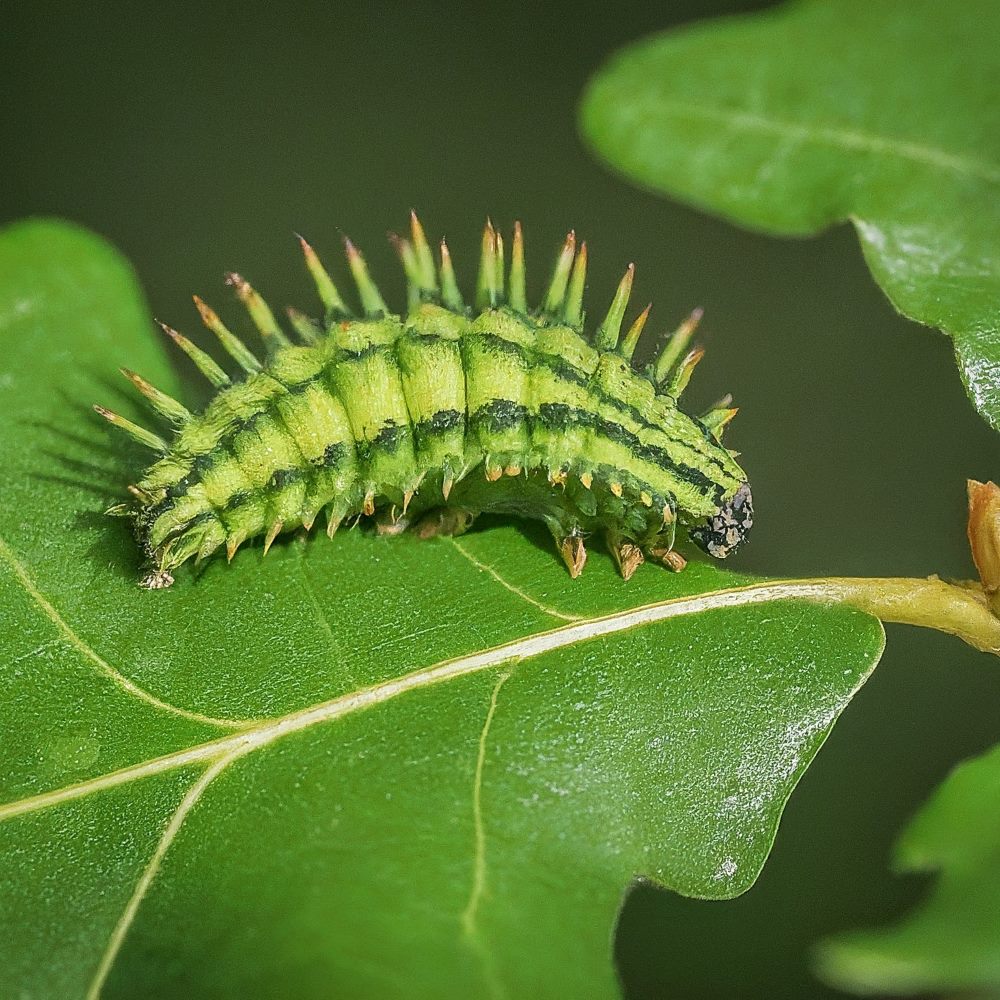
24. Spiny Oakworm (Anisota stigma)
Appearance: Spiny Oakworm caterpillars have black bodies with rows of bright orange spikes and longitudinal stripes along their sides.
Habitat: These caterpillars are native to North America and are commonly found in oak forests and woodlands.
Diet: Spiny Oakworm caterpillars feed on the leaves of various oak tree species, including white oak, red oak, and black oak.
Features and Facts: They are social caterpillars, often forming large groups on branches and feeding communally. Spiny Oakworm moths exhibit wings with intricate patterns of orange, black, and white as adults.
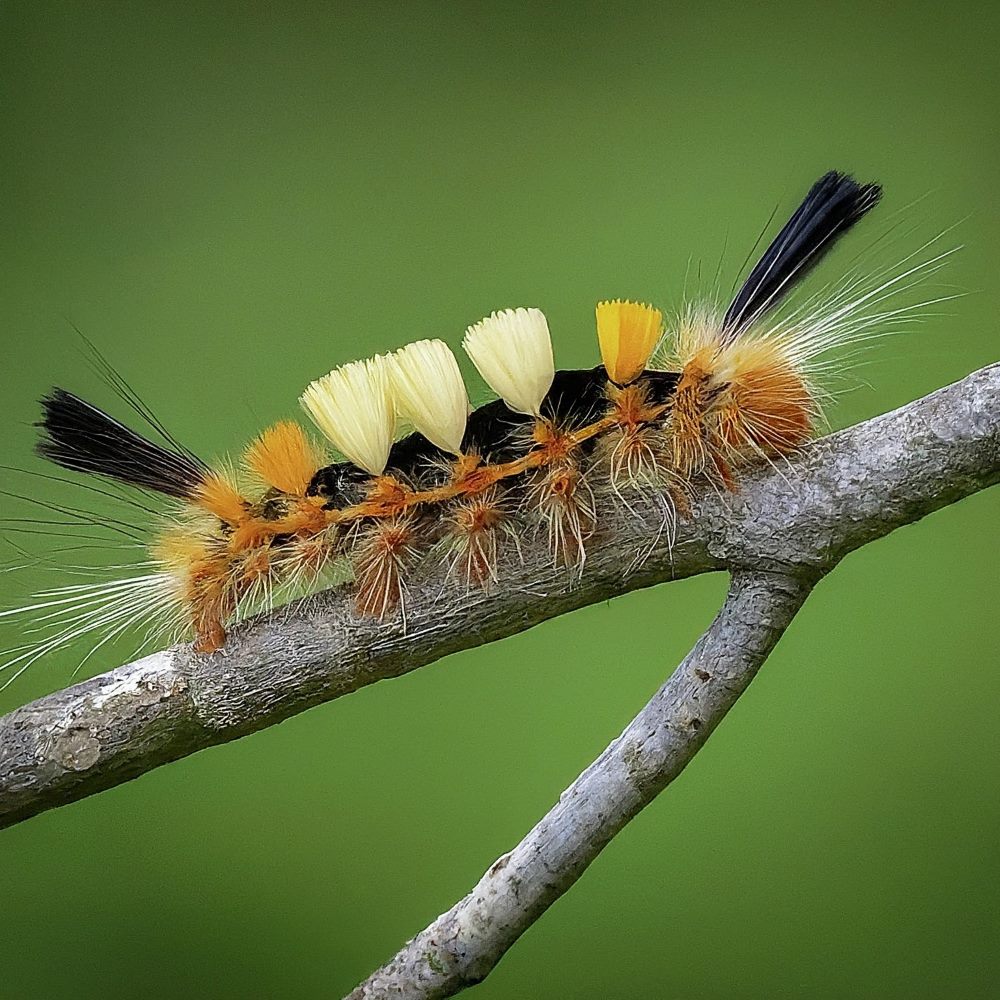
25. Rusty Tussock Moth Caterpillar (Orgyia antiqua)
Appearance: Rusty Tussock Moth caterpillars have black bodies with tufts of bright orange and black hairs along their backs.
Habitat: These caterpillars are found across Europe, Asia, and North America, particularly in woodlands and urban areas.
Diet: Rusty Tussock Moth caterpillars feed on the leaves of various trees and shrubs, including oak, birch, and hawthorn.
Features and Facts: They possess urticating hairs, which can cause skin irritation upon contact, serving as a defense mechanism against predators. Rusty Tussock Moth moths exhibit wings with intricate patterns of orange, black, and white as adults.
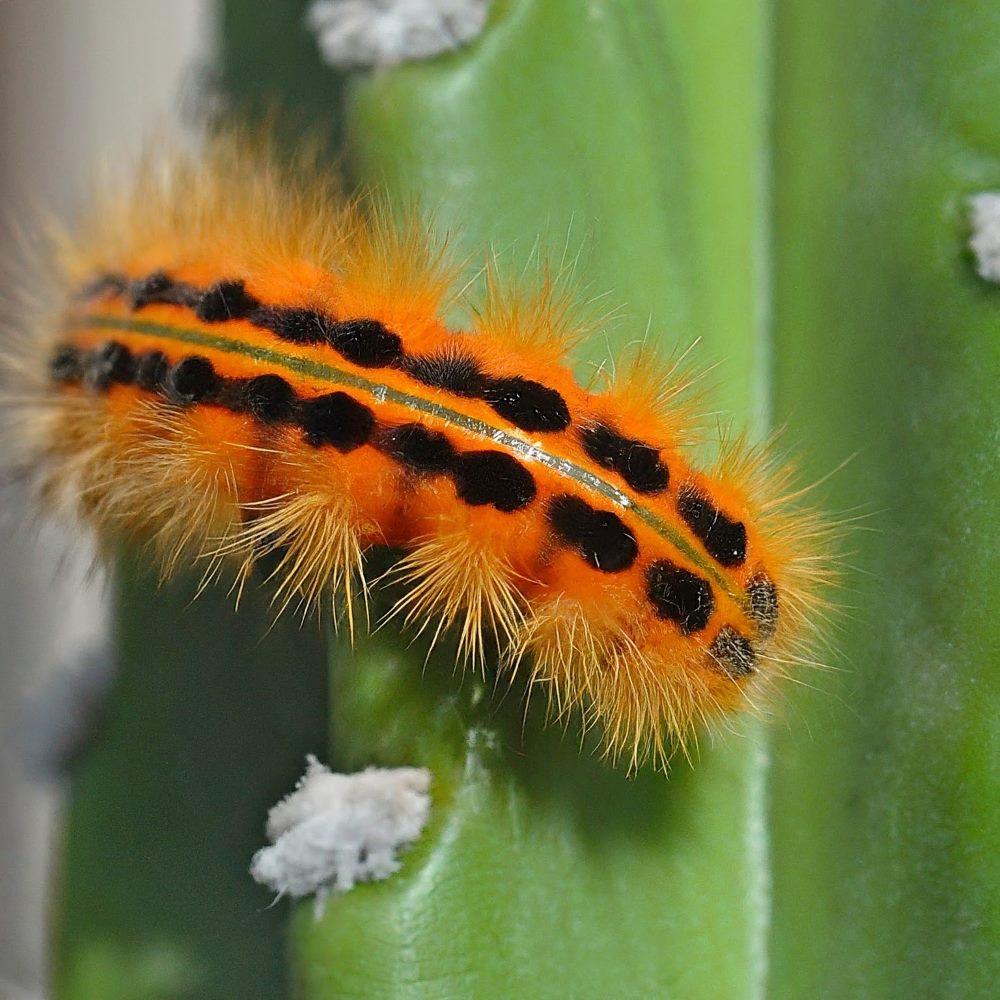
26. Cactus Moth Caterpillar (Cactoblastis cactorum)
Appearance: Cactus Moth caterpillars have black bodies with rows of bright orange spots and longitudinal stripes along their sides.
Habitat: These caterpillars are native to South America and have been introduced to various regions worldwide, particularly where cacti are present.
Diet: Cactus Moth caterpillars feed exclusively on the leaves of cactus plants (Cactaceae family), including prickly pear (Opuntia species) and cholla (Cylindropuntia species).
Features and Facts: They are considered invasive pests in regions where they have been introduced, posing a threat to native cactus populations. As adults, Cactus Moth moths exhibit wings with intricate patterns of orange, black, and white.
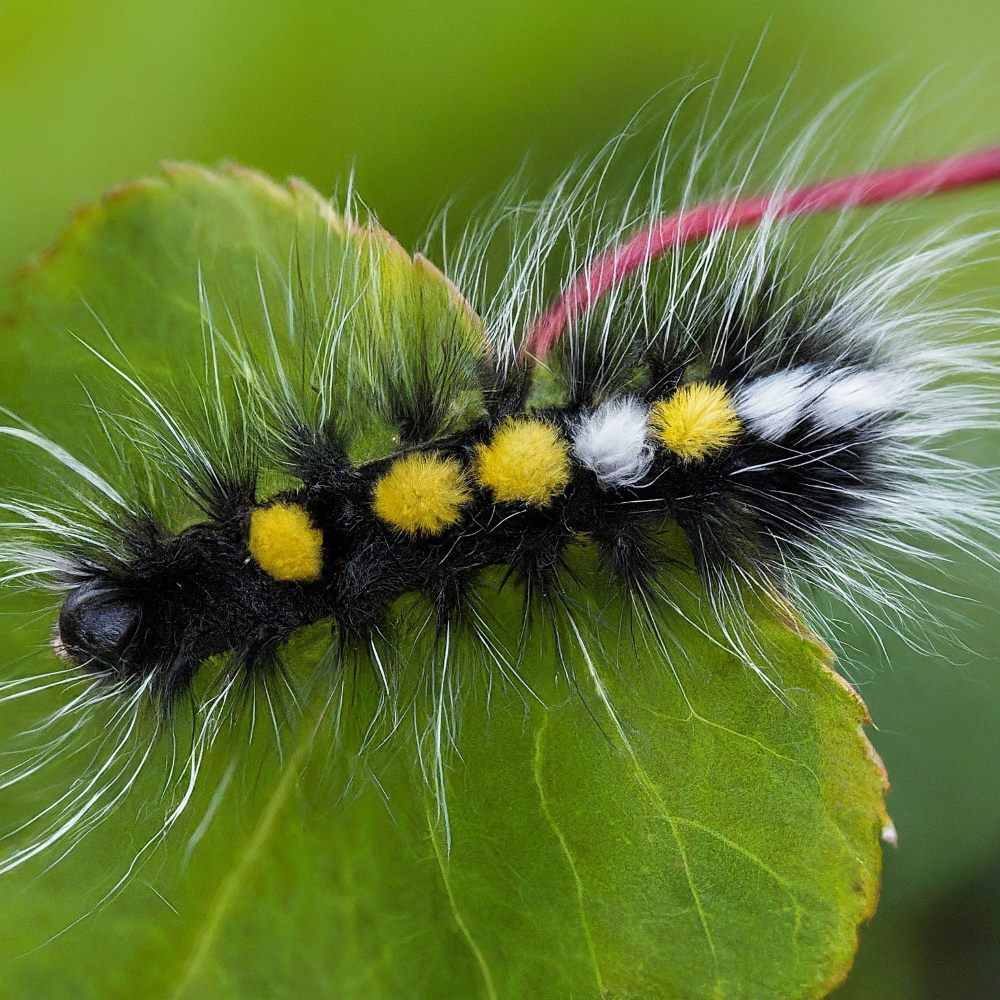
27. Silver-spotted Tiger Moth Caterpillar (Lophocampa argentata)
Appearance: Silver-spotted Tiger Moth caterpillars have black bodies with rows of bright orange spots and longitudinal stripes along their sides.
Habitat: These caterpillars are found across North and South America, particularly in forests, woodlands, and grasslands.
Diet: Silver-spotted Tiger Moth caterpillars feed on the leaves of various plants, including grasses, dandelions, and legumes.
Features and Facts: They possess urticating hairs, which can cause skin irritation upon contact, serving as a defense mechanism against predators. Silver-spotted Tiger Moth moths exhibit wings with intricate patterns of orange, black, and white as adults.
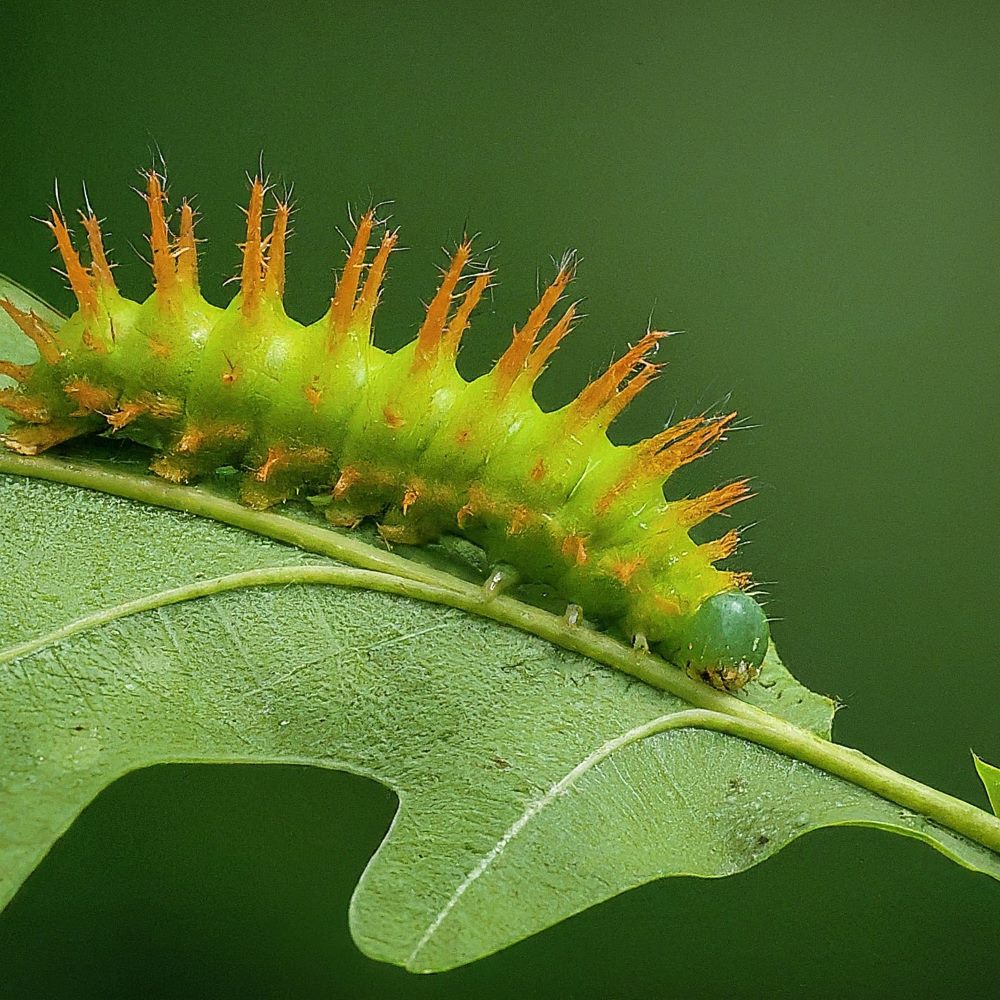
28. Orange-tipped Oakworm (Anisota senatoria)
Appearance: Orange-tipped Oakworm caterpillars have black bodies with bright orange bands and rows of spines along their backs.
Habitat: These caterpillars are native to North America and are commonly found in oak forests, woodlands, and urban areas.
Diet: Orange-tipped Oakworm caterpillars feed on the leaves of various oak tree species, including white oak, red oak, and black oak.
Features and Facts: They are social caterpillars, often forming large groups on branches and feeding communally. Orange-tipped Oakworm moths exhibit wings with intricate patterns of orange, black, and white as adults.
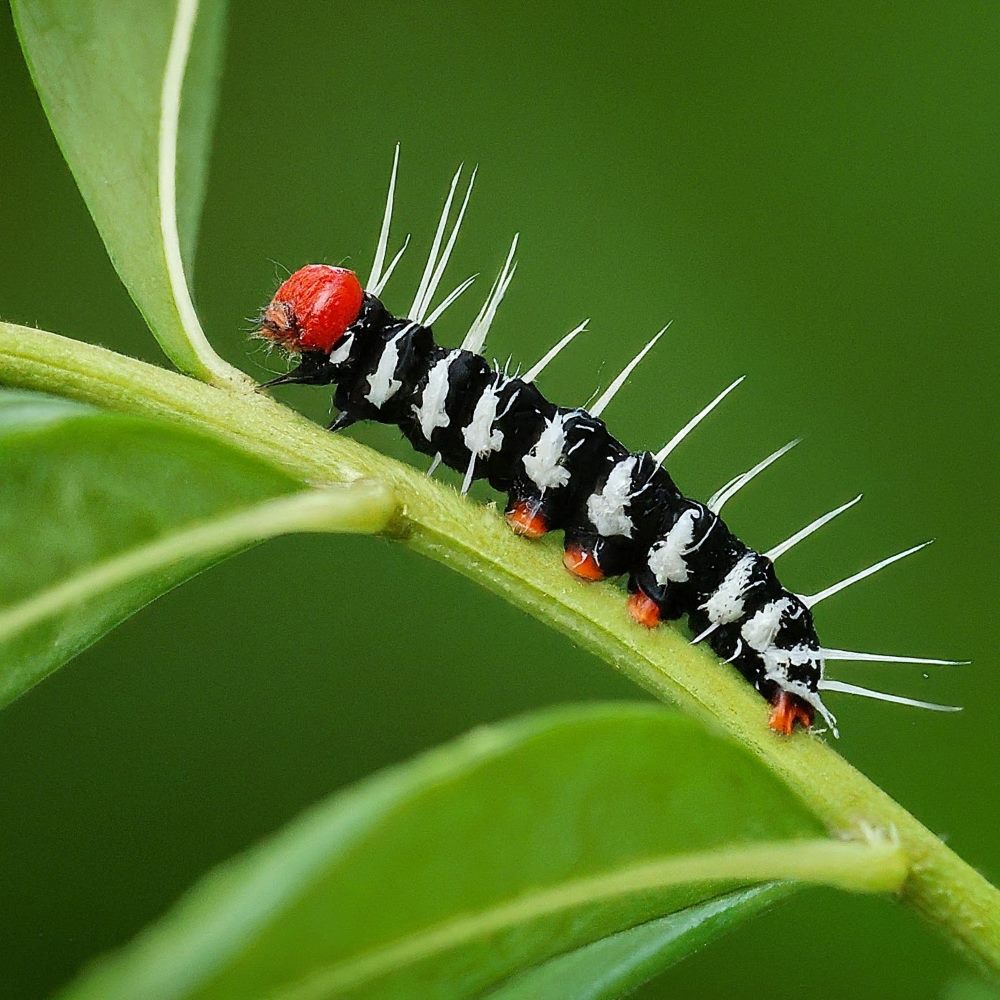
29. Unexpected Cycnia Moth Caterpillar (Cycnia inopinatus)
Appearance: Unexpected Cycnia Moth caterpillars have black bodies with rows of bright orange spots and stripes along their sides.
Habitat: These caterpillars are primarily found in North America, inhabiting grasslands, meadows, and urban areas.
Diet: Unexpected Cycnia Moth caterpillars feed on the leaves of various plants, including grasses, dandelions, and legumes.
Features and Facts: They are cryptic against their host plants, blending in with grasses and foliage. Unexpected Cycnia Moth moths exhibit wings with intricate patterns of orange, black, and white as adults.
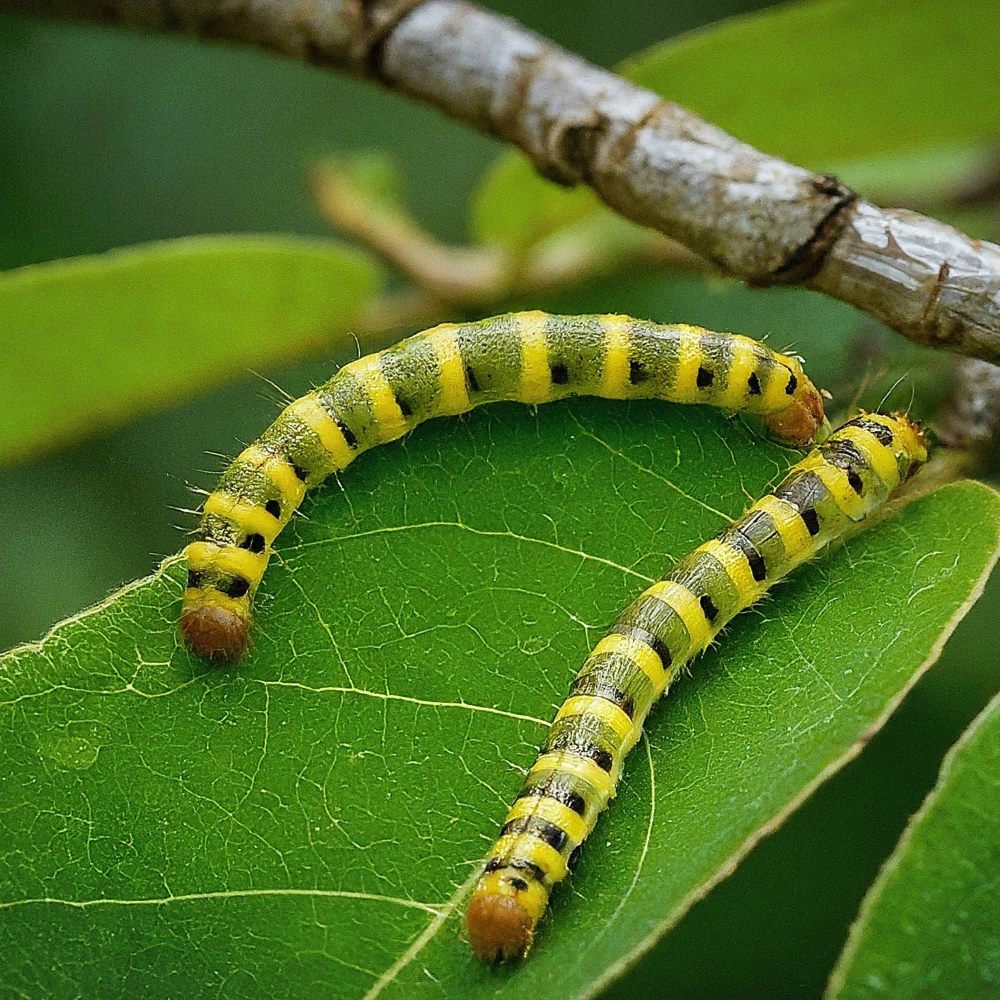
30. Buck Moth Caterpillar (Hemileuca maia)
Appearance: Buck Moth caterpillars have black bodies with rows of bright orange spots and stripes along their sides.
Habitat: These caterpillars are found across North America, particularly in forests, woodlands, and urban areas.
Diet: Buck Moth caterpillars feed on the leaves of various plants, including oak, birch, and willow.
Features and Facts: They possess urticating hairs, which can cause skin irritation upon contact, serving as a defense mechanism against predators. Buck Moth moths exhibit wings with intricate patterns of orange, black, and white as adults.
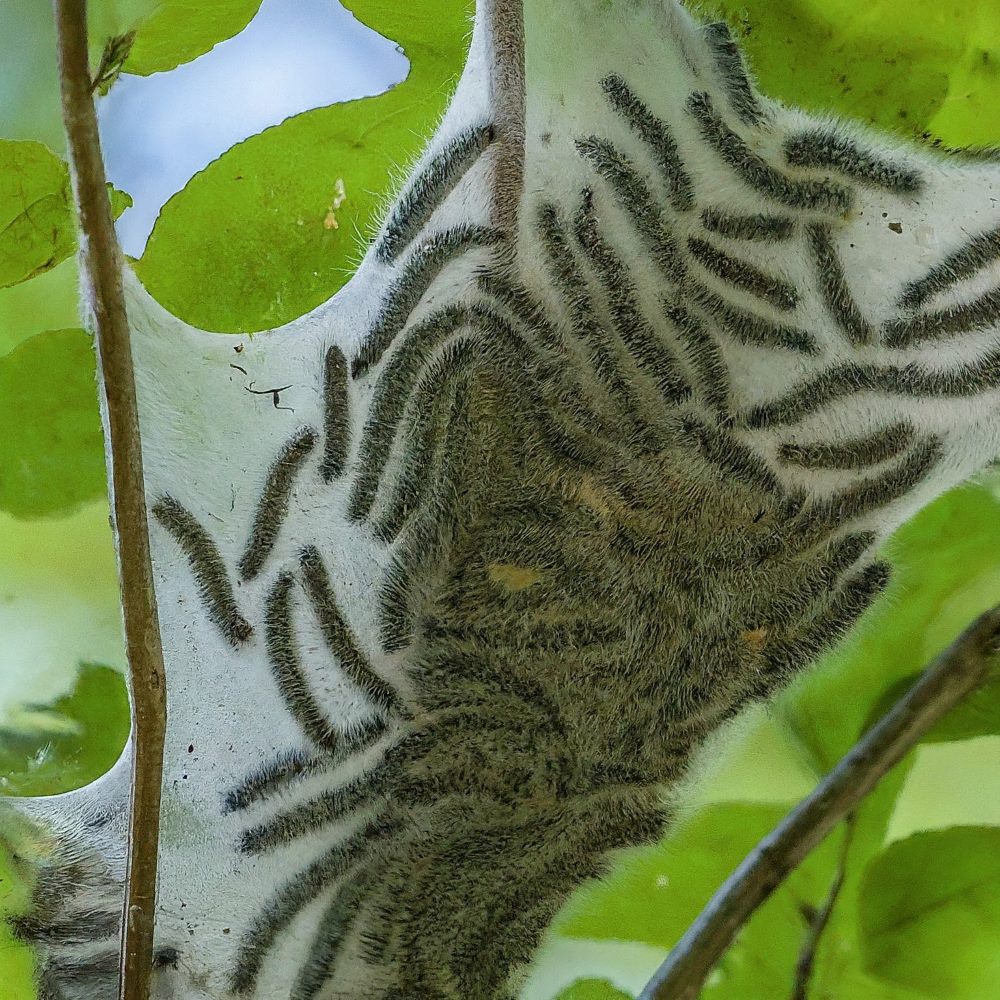
31. Eastern Tent Caterpillar (Malacosoma americanum)
Appearance: Eastern Tent caterpillars have black bodies with bright orange spots and stripes along their sides.
Habitat: These caterpillars are native to North America and are commonly found in deciduous forests, woodlands, and urban areas.
Diet: Eastern Tent caterpillars feed on the leaves of various trees, including cherry, apple, and hawthorn.
Features and Facts: They construct silk tents in the branches of trees, where they rest and feed communally. Eastern Tent moths exhibit wings with intricate patterns of orange, black, and white as adults.
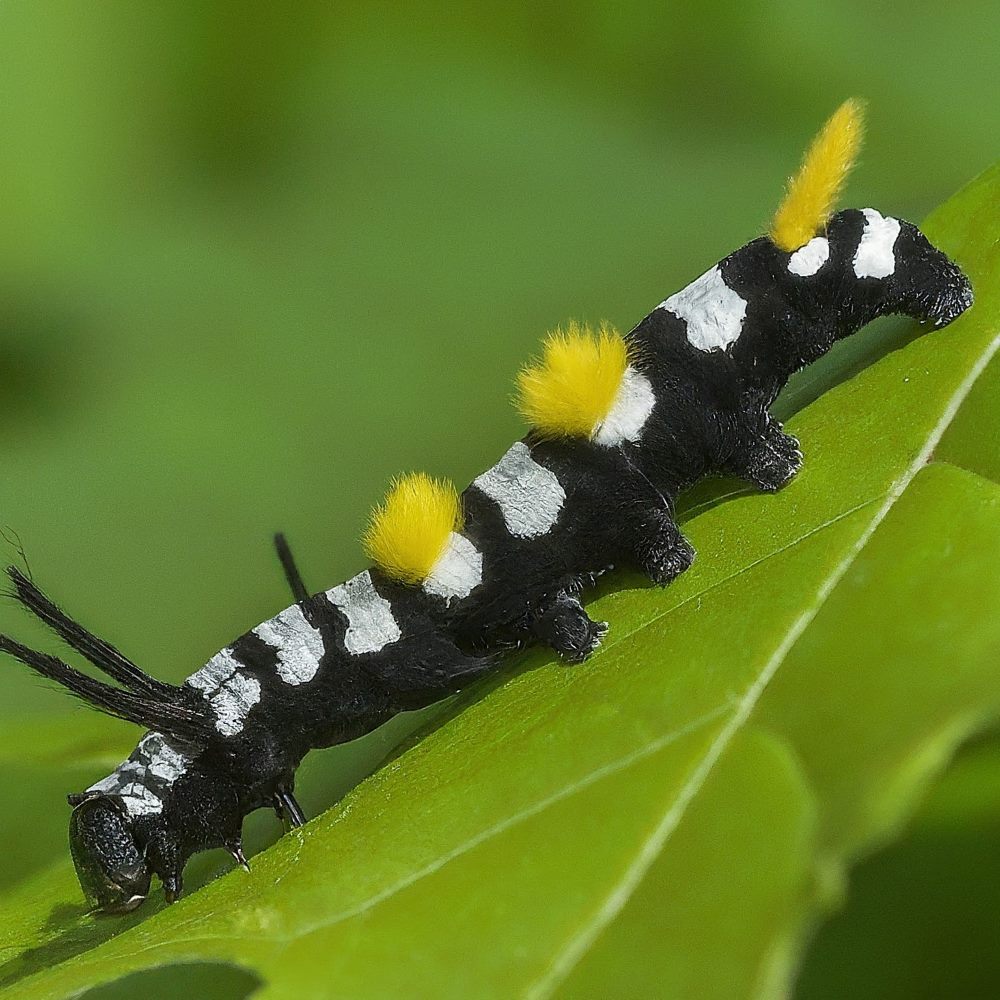
32. Yellow-winged Pareuchaetes Moth (Pareuchaetes insulata)
Appearance: Yellow-winged Pareuchaetes Moth caterpillars have black bodies with rows of bright orange spots and stripes along their sides.
Habitat: These caterpillars are primarily found in Africa, particularly in grasslands, savannas, and agricultural areas.
Diet: Yellow-winged Pareuchaetes Moth caterpillars feed on the leaves of various plants, including grasses, dandelions, and legumes.
Features and Facts: They are highly mobile and may migrate in large numbers to find suitable breeding and feeding grounds. Yellow-winged Pareuchaetes Moth moths exhibit wings with intricate patterns of orange, black, and white as adults.
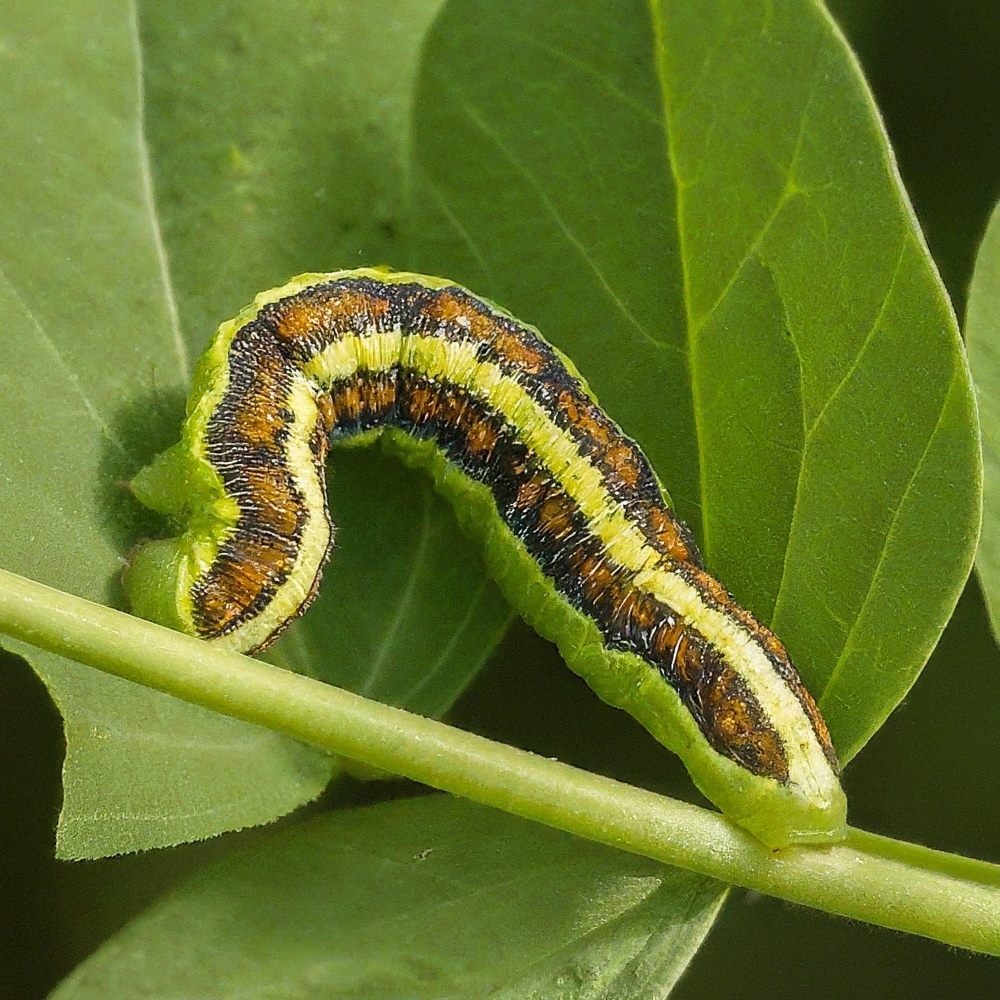
33. Legume Caterpillar (Uresiphita reversalis)
Appearance: Legume caterpillars have black bodies with rows of bright orange spots and stripes along their sides.
Habitat: These caterpillars are primarily found in North and South America, particularly in grasslands, meadows, and agricultural areas.
Diet: Legume caterpillars feed on the leaves of various legume plants, including beans, peas, and alfalfa.
Features and Facts: They are considered agricultural pests, causing damage to crops and reducing yields. Legume moths exhibit wings with intricate patterns of orange, black, and white as adults.
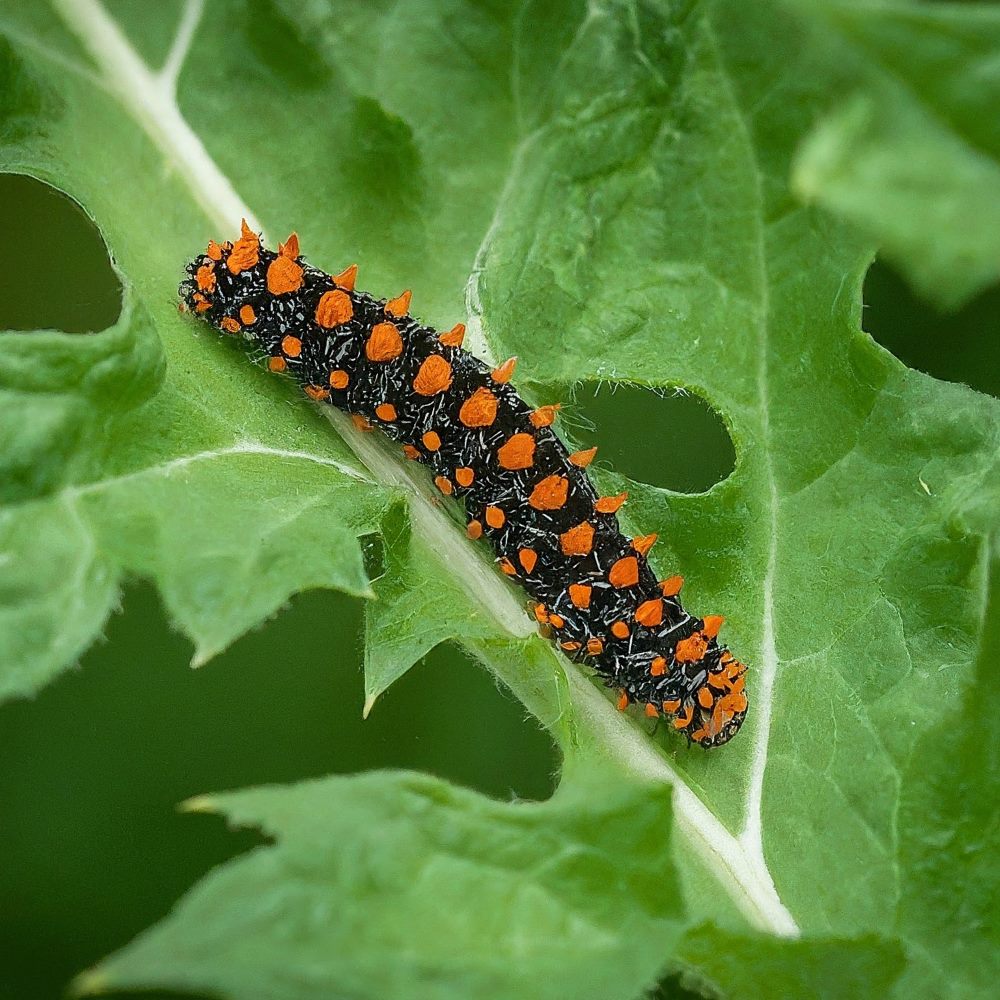
34. Baltimore Checkerspot Caterpillar (Euphydryas phaeton)
Appearance: Baltimore Checkerspot caterpillars have black bodies with bright orange bands and rows of spines along their backs.
Habitat: These caterpillars are native to North America and are commonly found in wetlands, meadows, and grasslands.
Diet: Baltimore Checkerspot caterpillars feed on the leaves of various plants, including turtlehead (Chelone species) and figwort (Scrophularia species).
Features and Facts: They are known for their synchronized group behavior, where they move in unison to create the appearance of a larger organism, deterring potential predators. Baltimore Checkerspot butterflies exhibit wings with intricate patterns of orange, black, and white as adults.
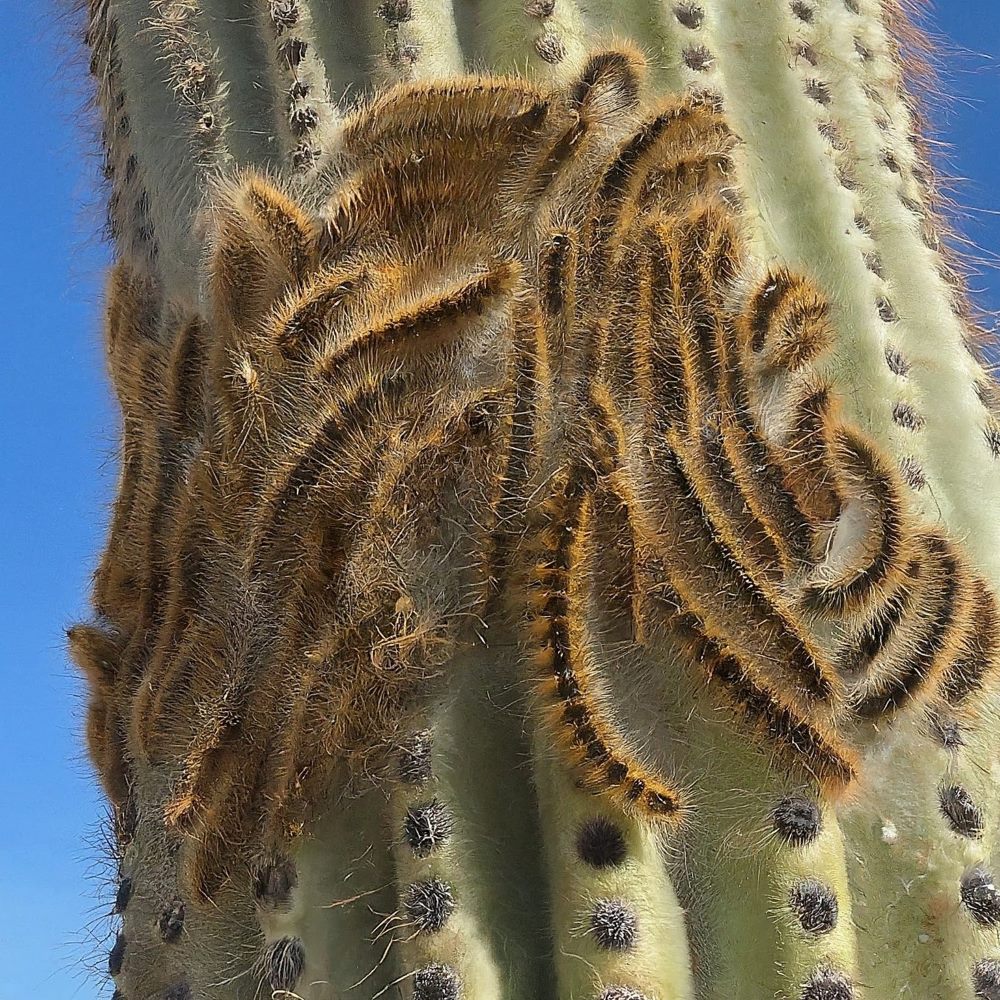
35. Sonoran Tent Caterpillar (Malacosoma sonorae)
Appearance: Sonoran Tent caterpillars have black bodies with rows of bright orange spots and stripes along their sides.
Habitat: These caterpillars are primarily found in North America, particularly in desert habitats, including Sonoran Desert regions.
Diet: Sonoran Tent caterpillars feed on the leaves of various trees and shrubs, including desert willow (Chilopsis linearis) and mesquite (Prosopis species).
Features and Facts: They construct silk tents in the branches of desert plants, where they rest and feed communally. Sonoran Tent moths exhibit wings with intricate patterns of orange, black, and white as adults.
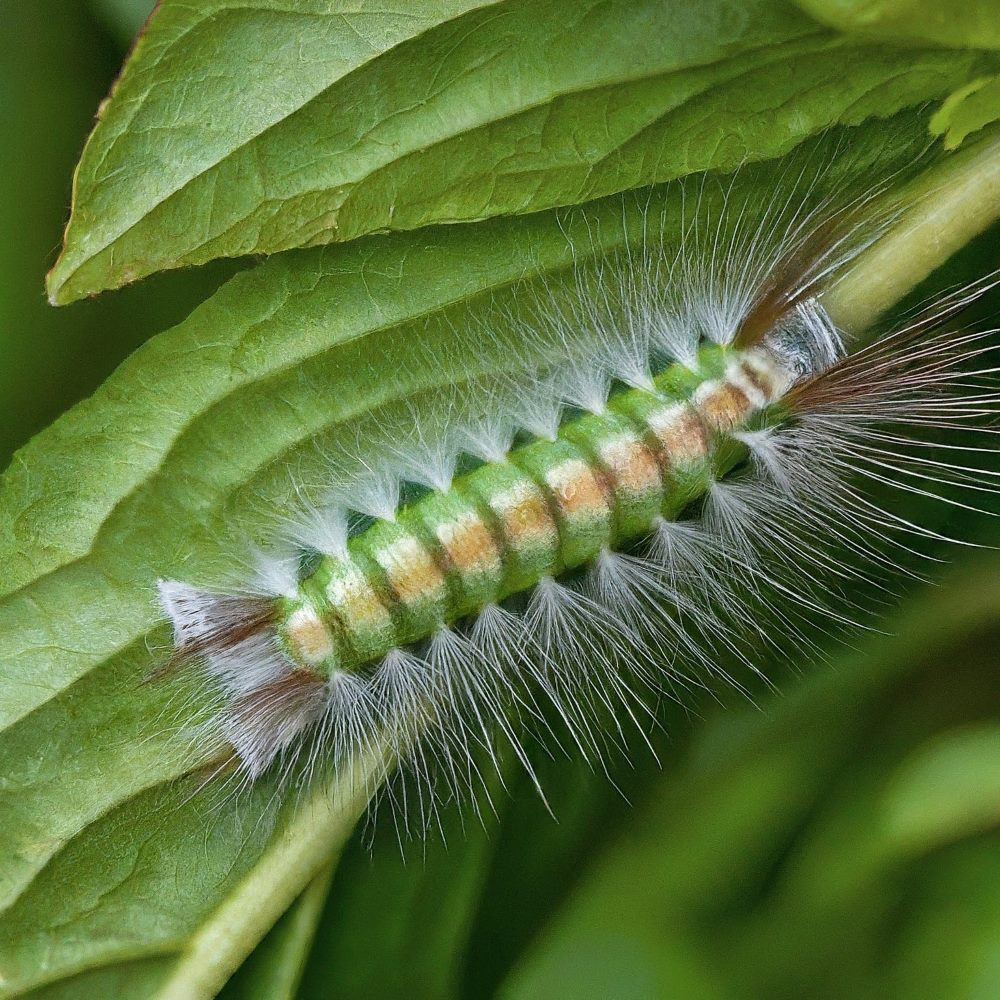
36. Powdered Dagger Caterpillar (Acronicta leporina)
Appearance: Powdered Dagger caterpillars have black bodies with rows of bright orange spots and stripes along their sides.
Habitat: These caterpillars are found across Europe and Asia, particularly in woodlands, forests, and urban areas.
Diet: Powdered Dagger caterpillars feed on the leaves of various trees and shrubs, including oak, birch, and willow.
Features and Facts: They possess urticating hairs, which can cause skin irritation upon contact, serving as a defense mechanism against predators. Powdered Dagger moths exhibit wings with intricate patterns of orange, black, and white as adults.
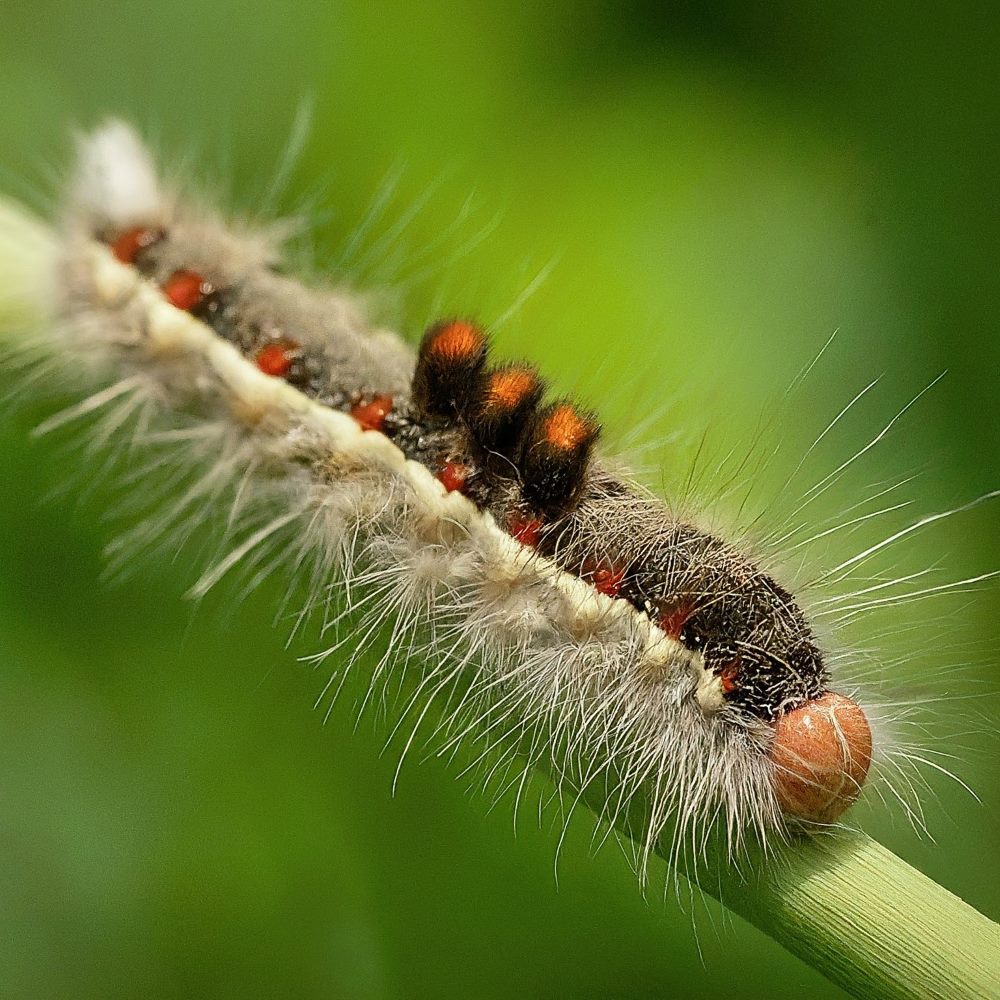
37. Large Gray Dagger Caterpillar (Acronicta megacephala)
Appearance: Large Gray Dagger caterpillars have black bodies with rows of bright orange spots and stripes along their sides.
Habitat: These caterpillars are primarily found in North America, particularly in woodlands, forests, and urban areas.
Diet: Large Gray Dagger caterpillars feed on the leaves of various trees and shrubs, including oak, birch, and willow.
Features and Facts: They possess urticating hairs, which can cause skin irritation upon contact, serving as a defense mechanism against predators. Large Gray Dagger moths exhibit wings with intricate patterns of orange, black, and white as adults.
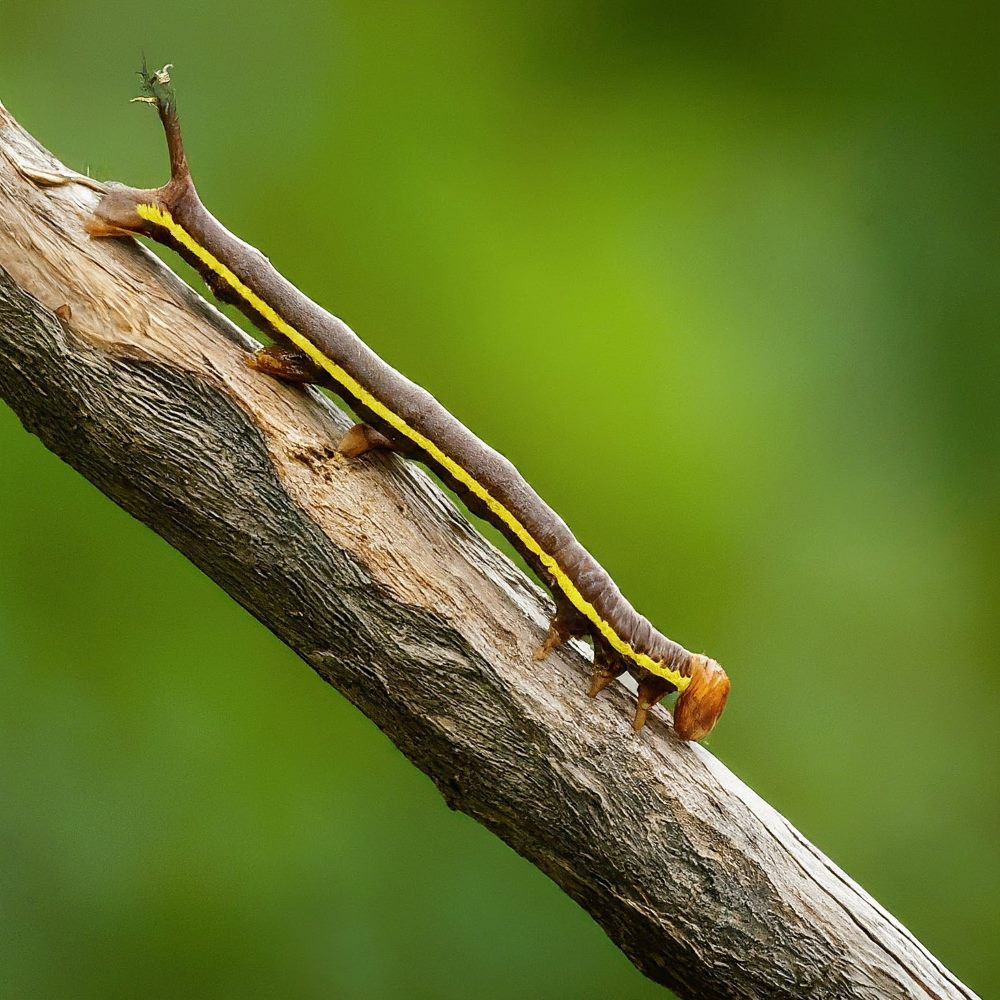
38. Western Sheep Moth Caterpillar (Hemileuca eglanterina)
Appearance: Western Sheep Moth caterpillars have black bodies with bright orange bands and rows of spines along their backs.
Habitat: These caterpillars are found across North America, particularly in grasslands, meadows, and urban areas.
Diet: Western Sheep Moth caterpillars feed on the leaves of various plants, including grasses, dandelions, and legumes.
Features and Facts: They are known for their synchronized group behavior, where they move in unison to create the appearance of a larger organism, deterring potential predators. Western Sheep Moth moths exhibit wings with intricate patterns of orange, black, and white as adults.
Summary
Orange and black caterpillars represent a diverse and captivating group of insects, showcasing a wide range of adaptations, behaviors, and ecological roles. From their vibrant coloration to their fascinating feeding habits, these caterpillars play essential roles in their respective ecosystems and serve as indicators of environmental health. By understanding and appreciating the unique characteristics of each species, we can gain valuable insights into the complex dynamics of the natural world and the interconnectedness of all living organisms.

94% of pet owners say their animal pal makes them smile more than once a day. In 2007, I realized that I was made for saving Animals. My father is a Vet, and I think every pet deserves one. I started this blog, “InPetCare”, in 2019 with my father to enlighten a wider audience.
